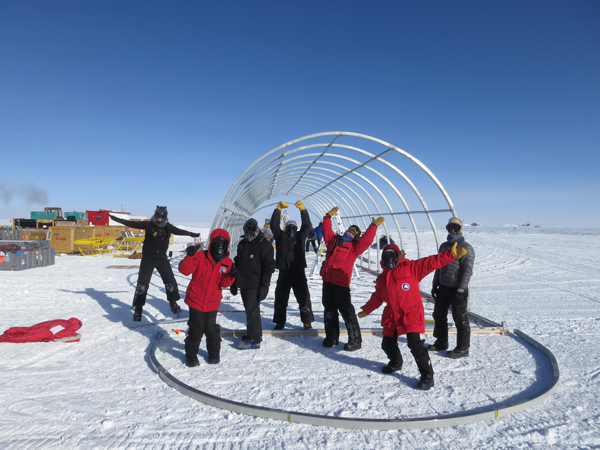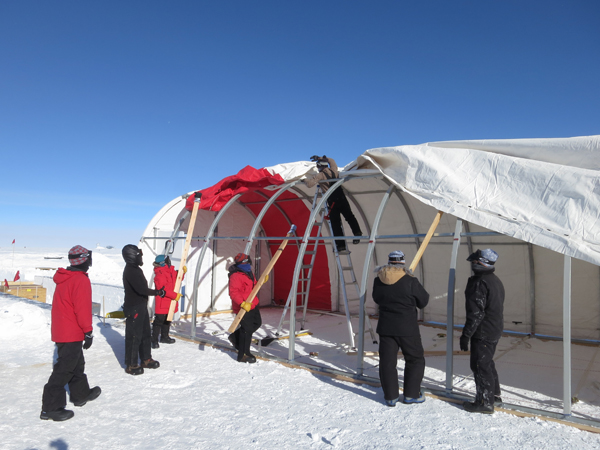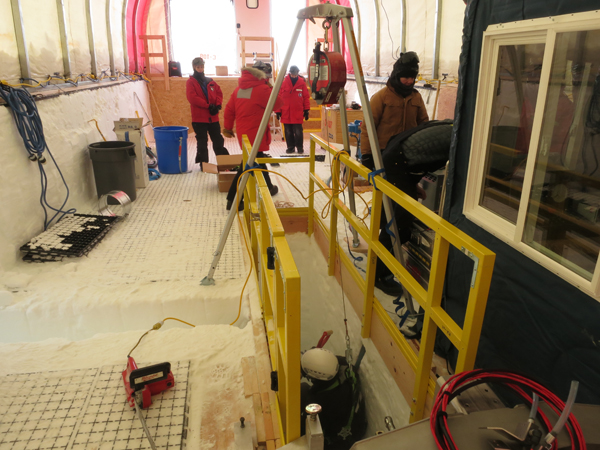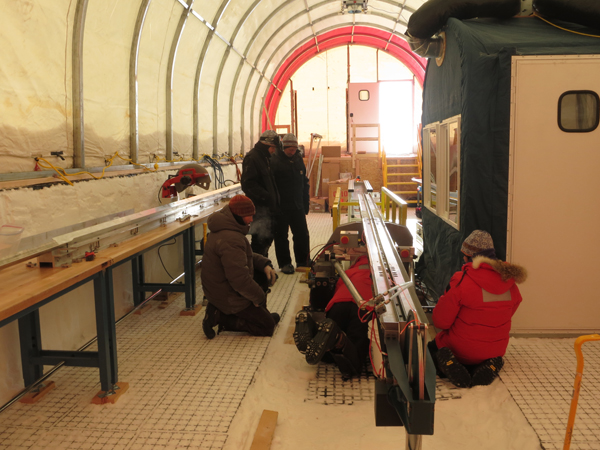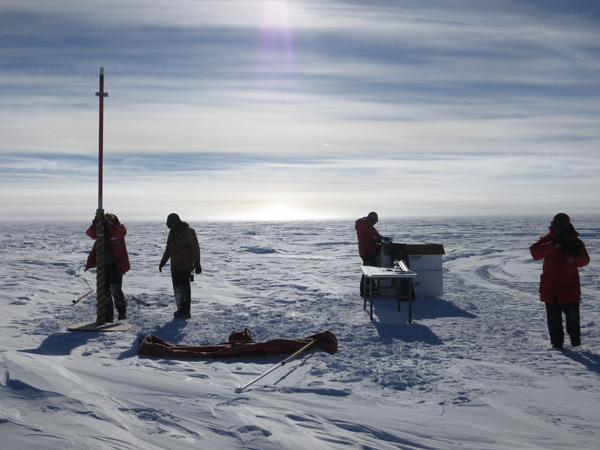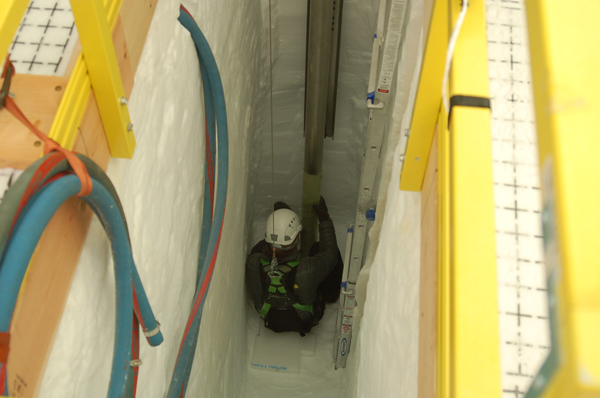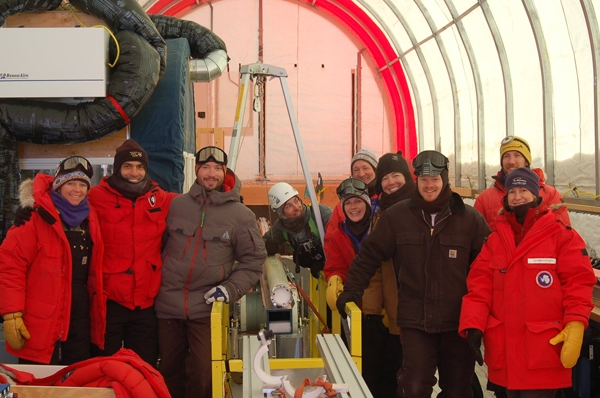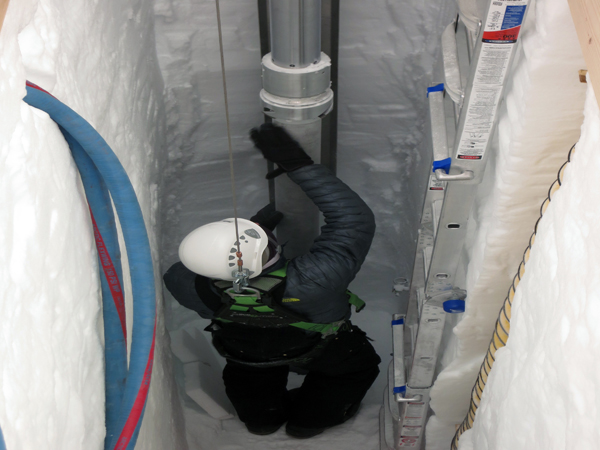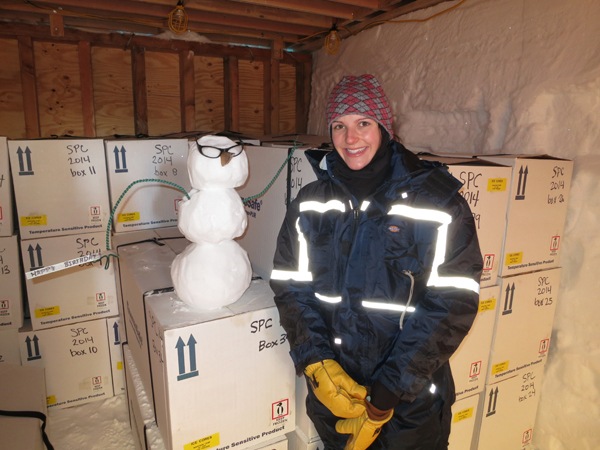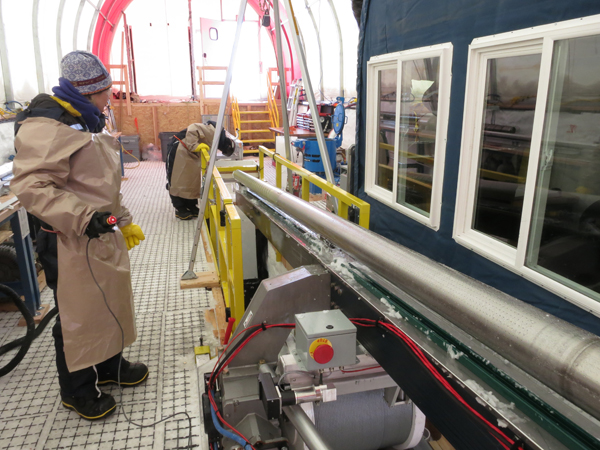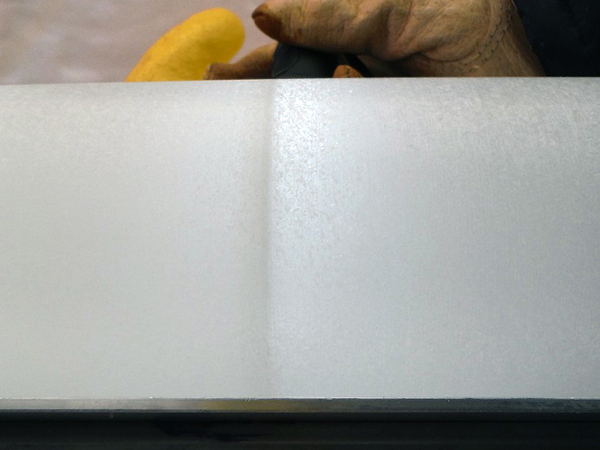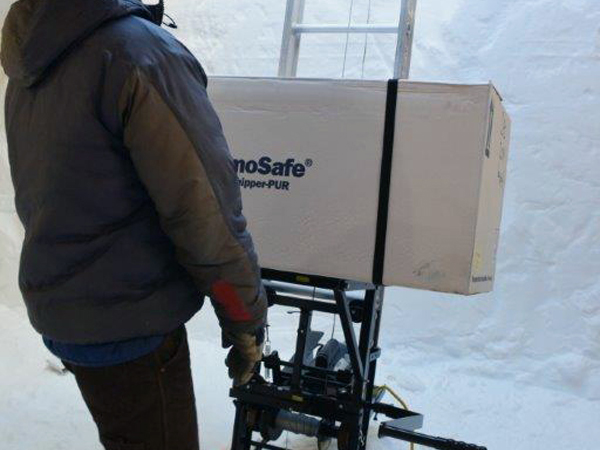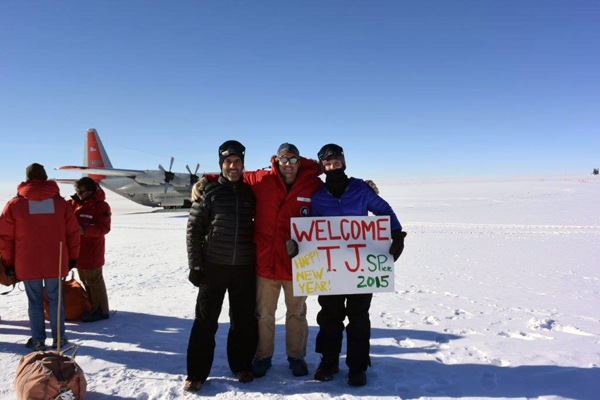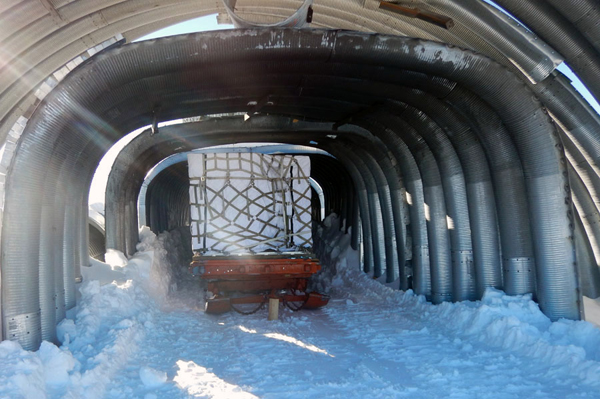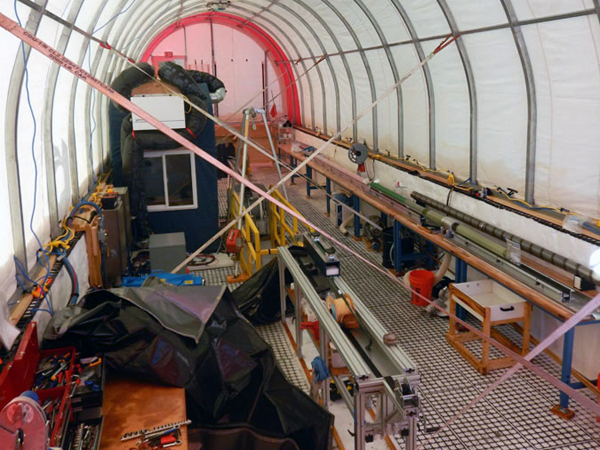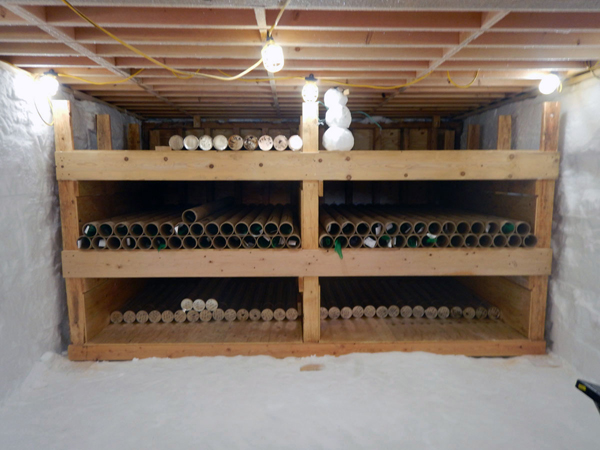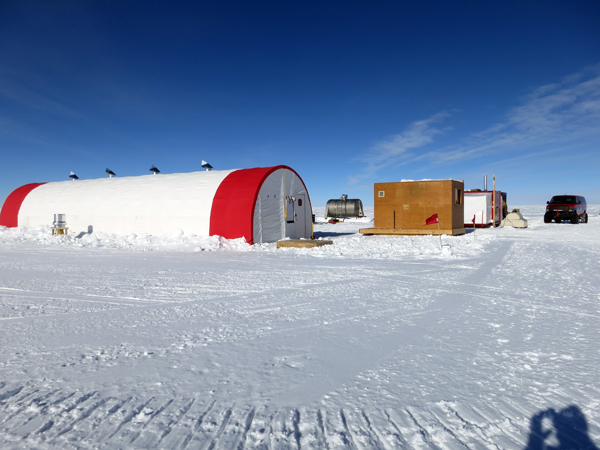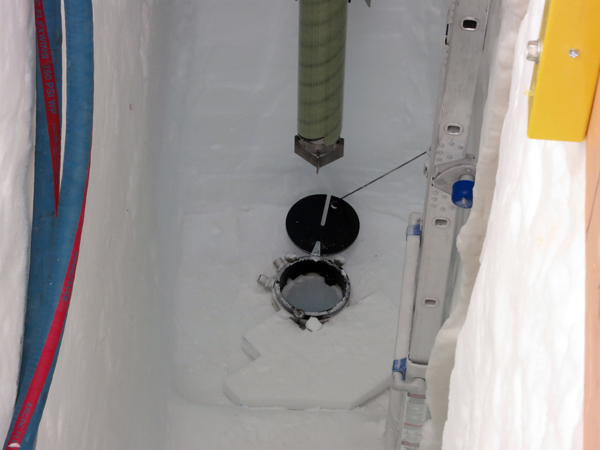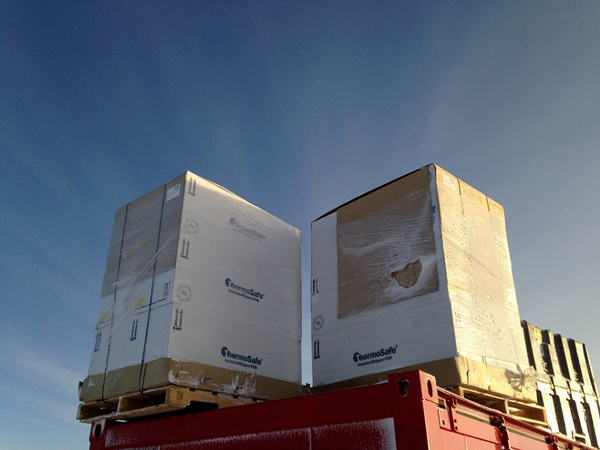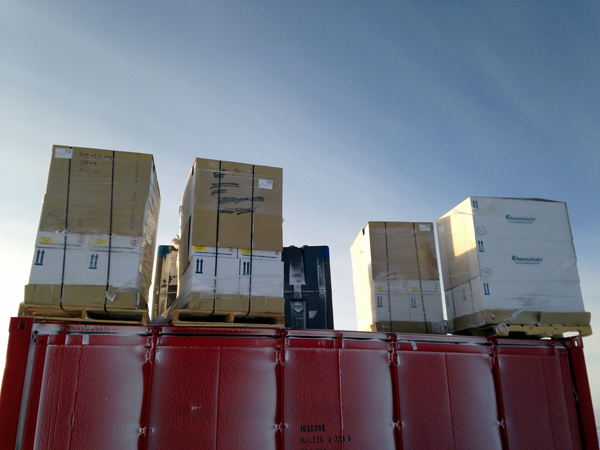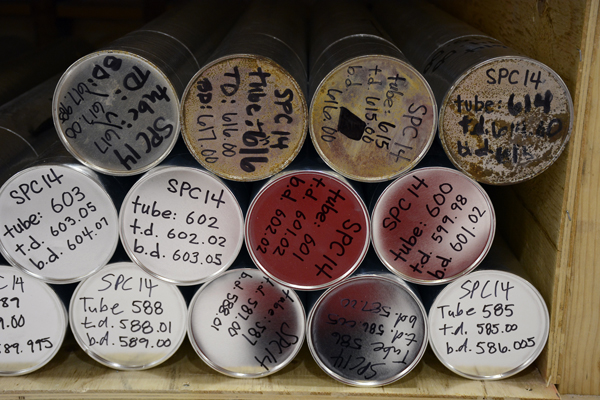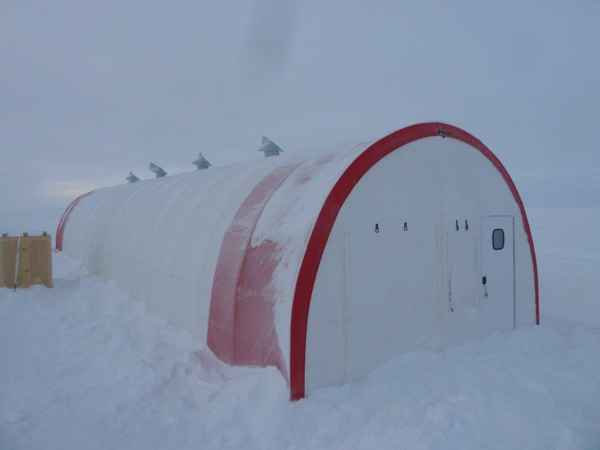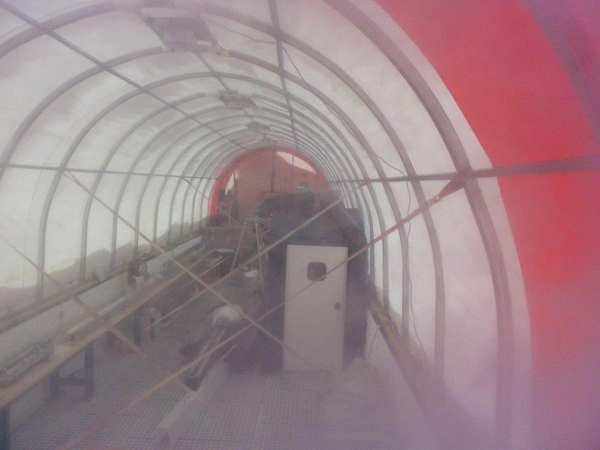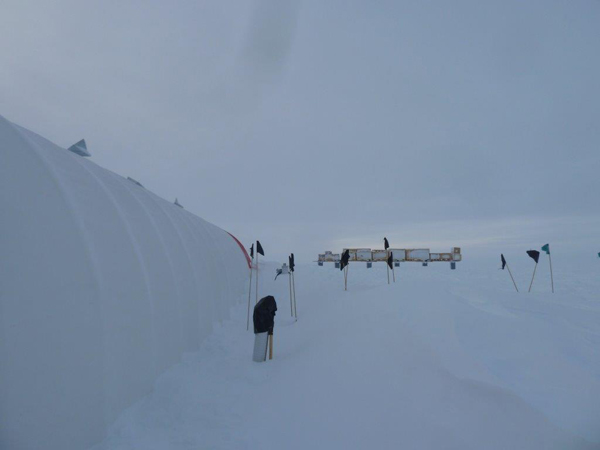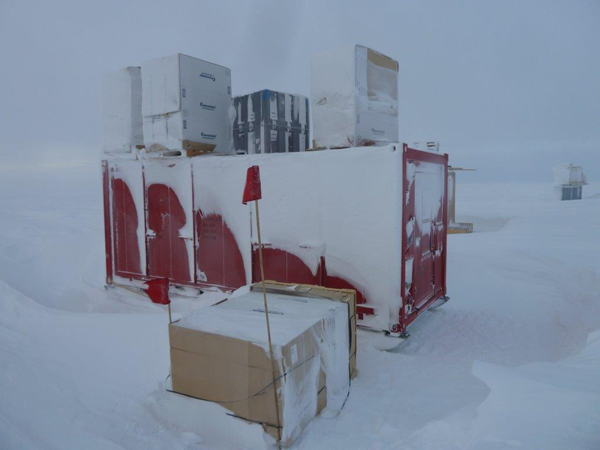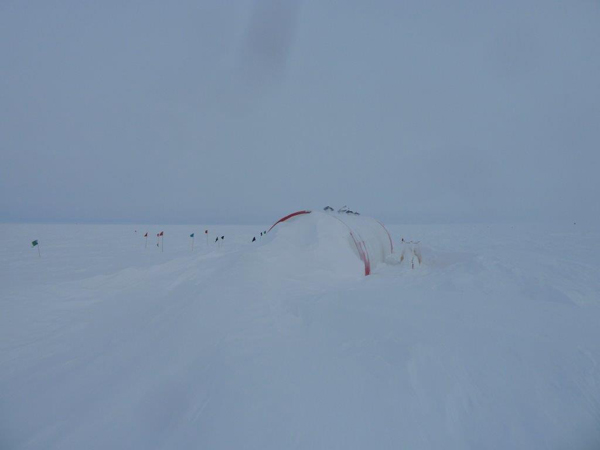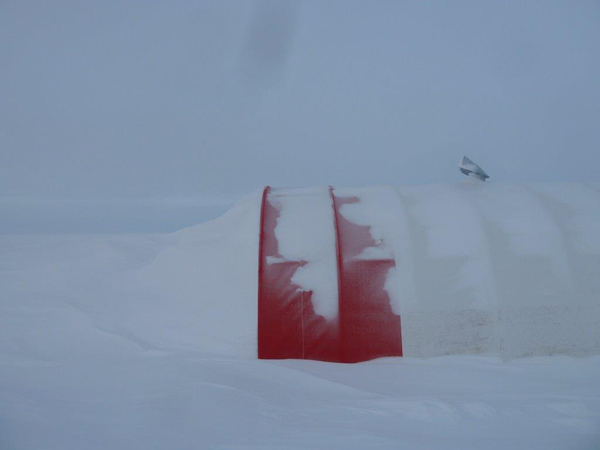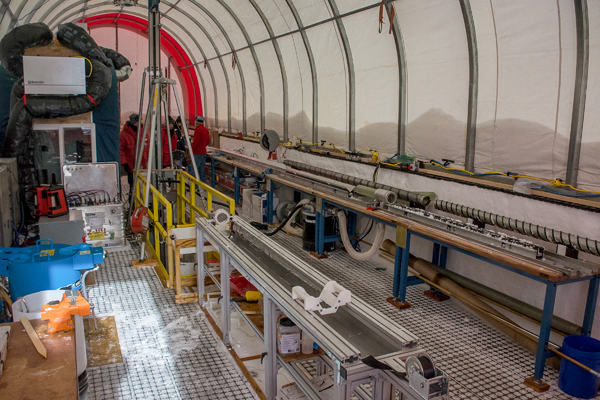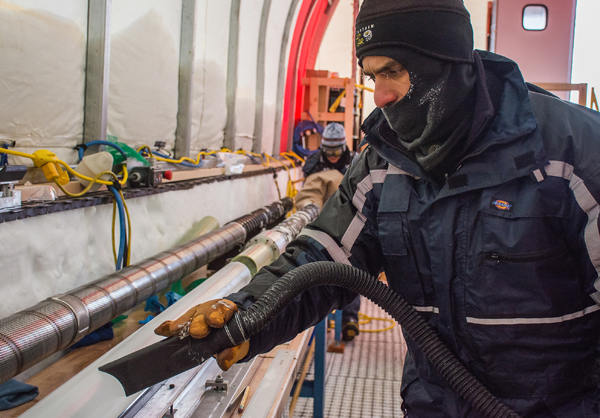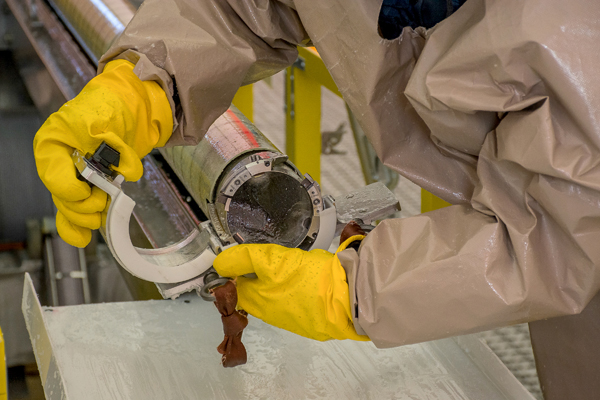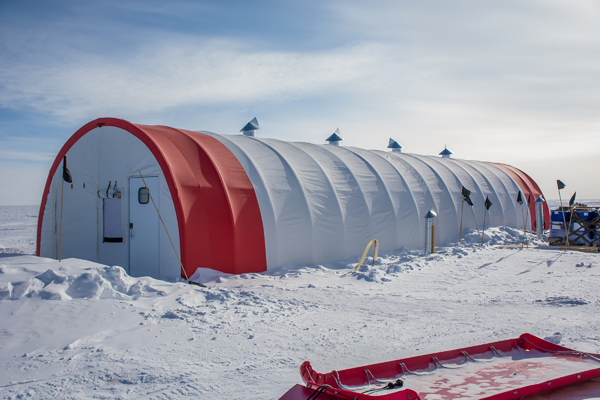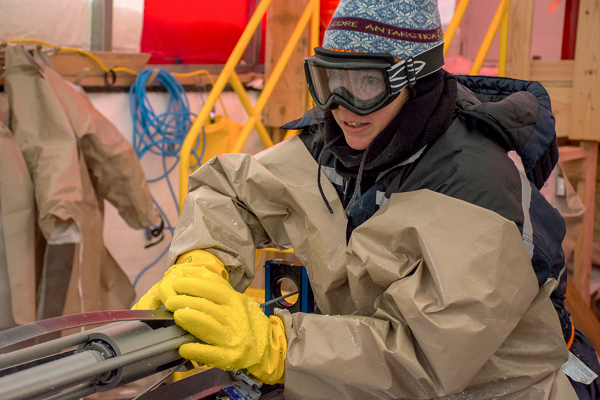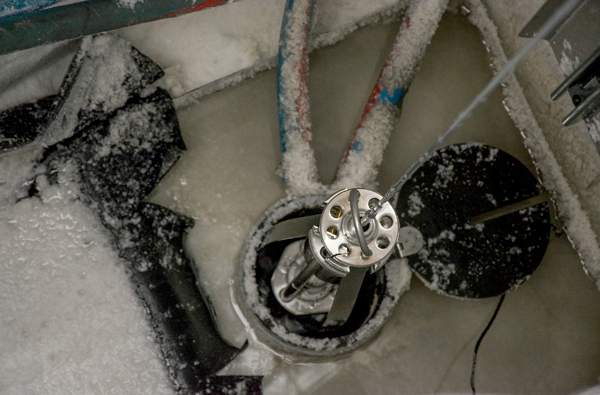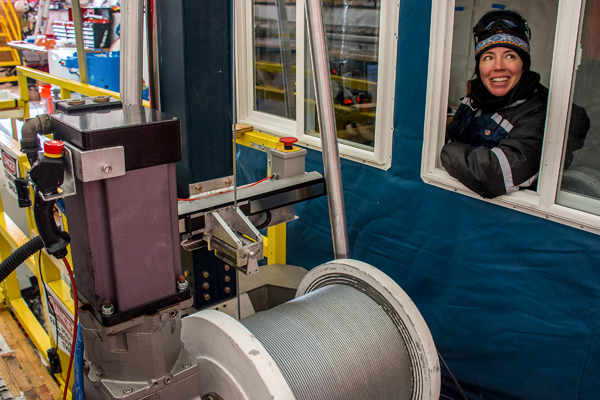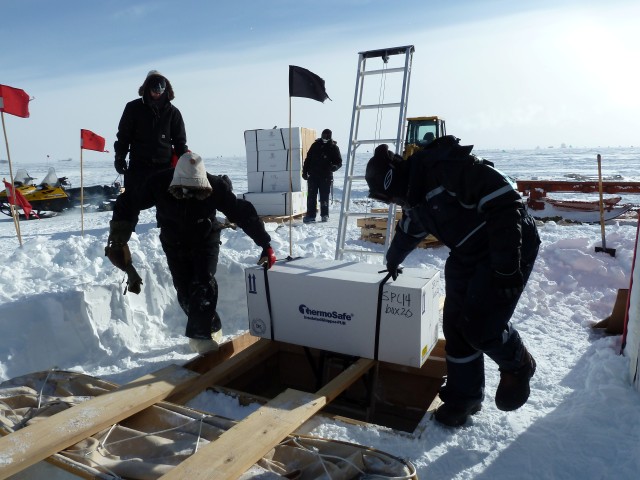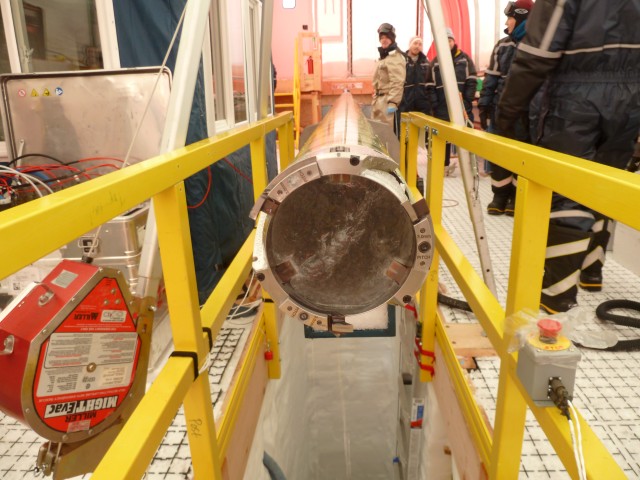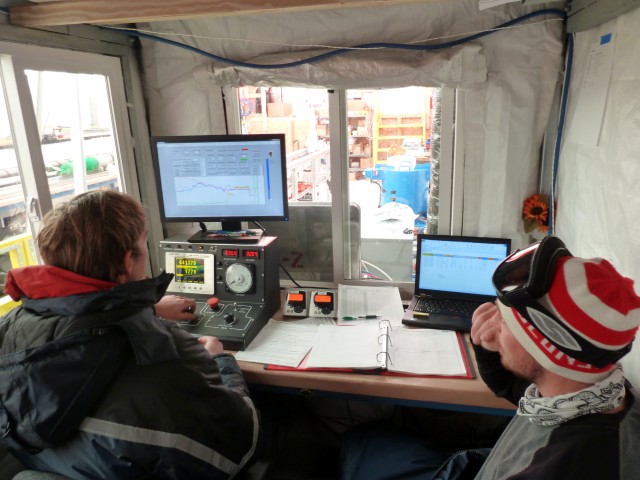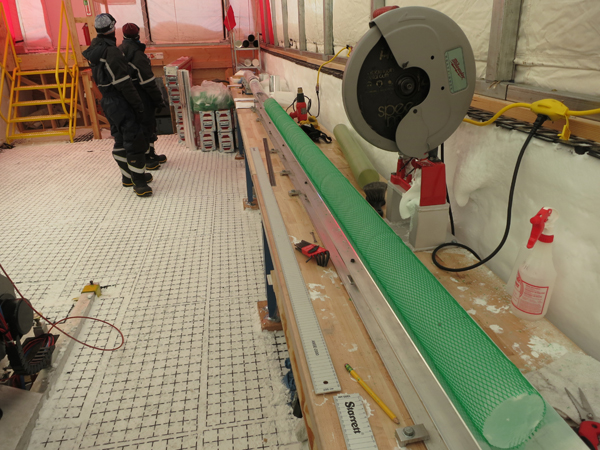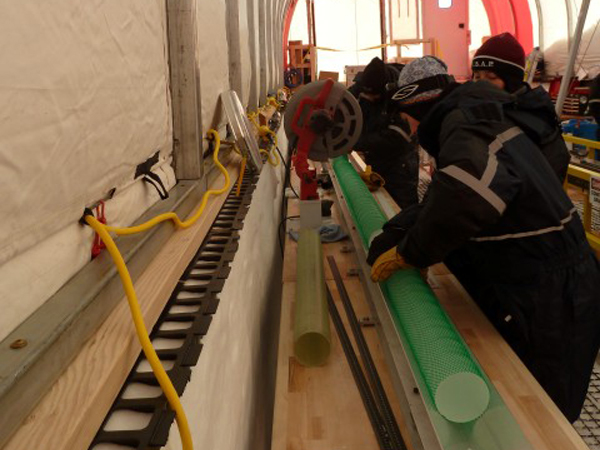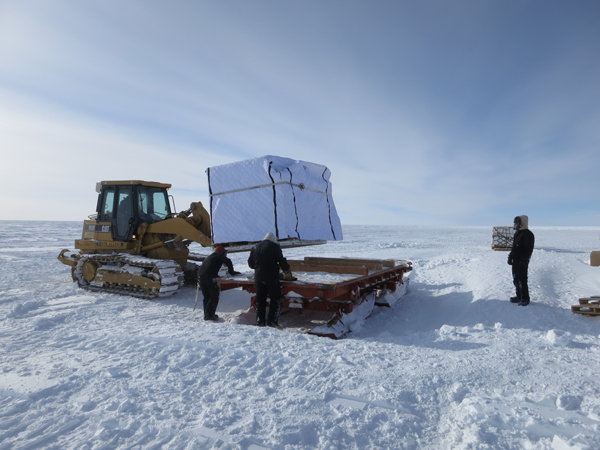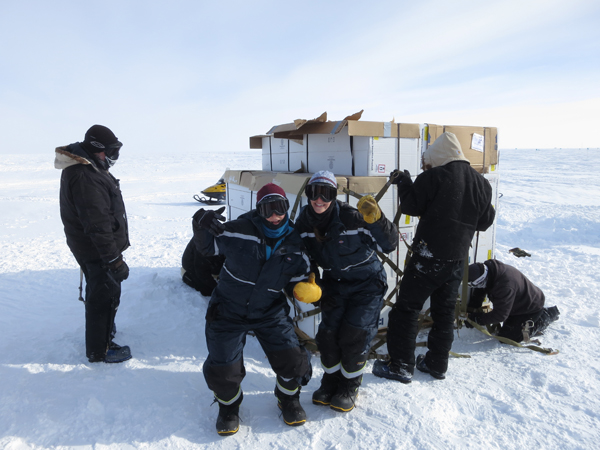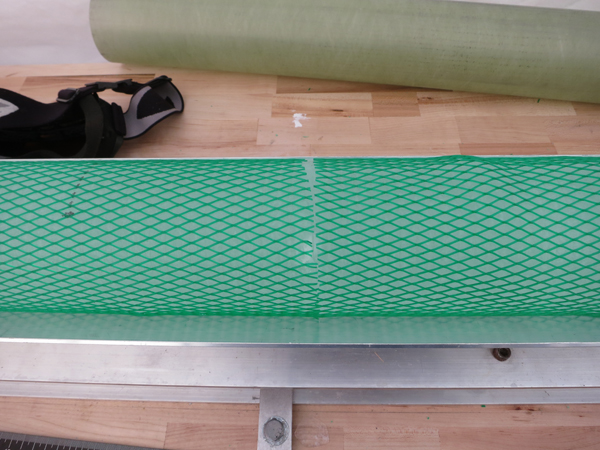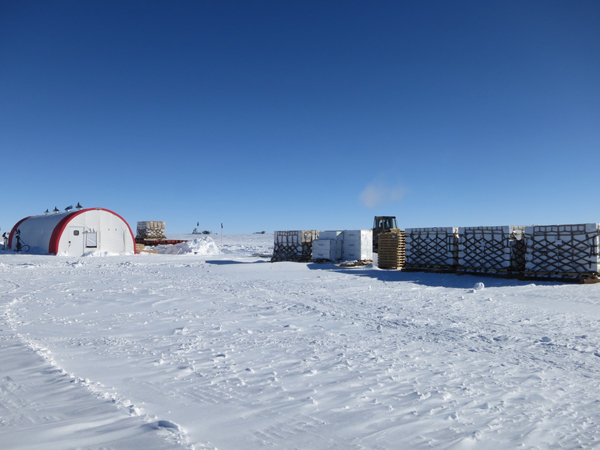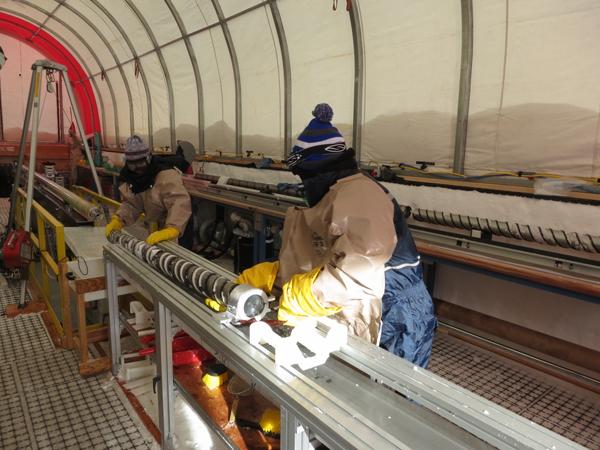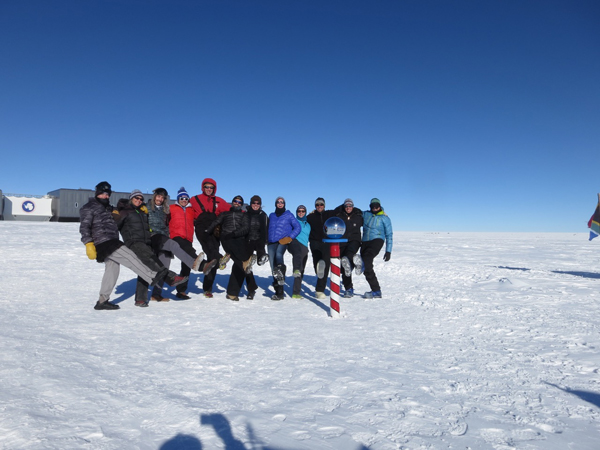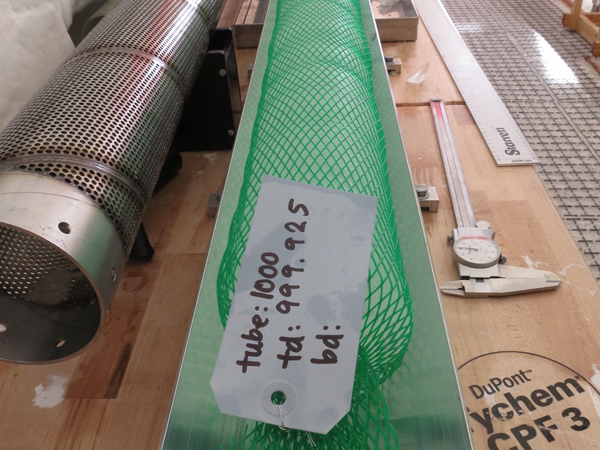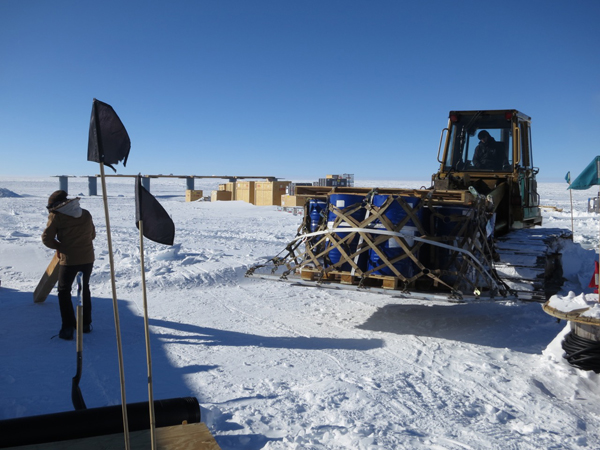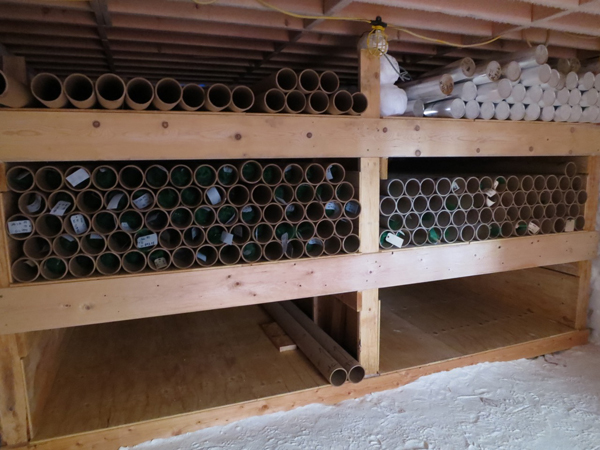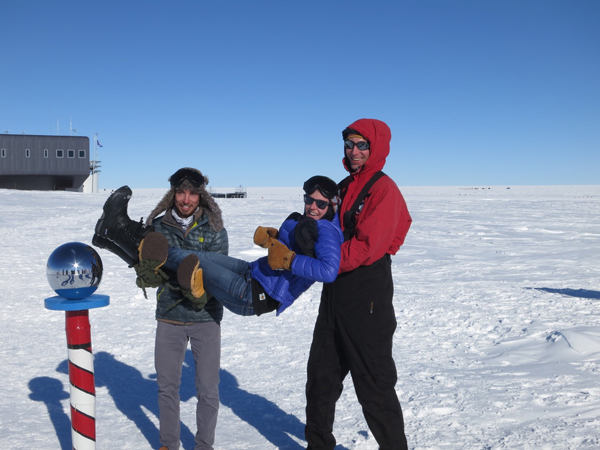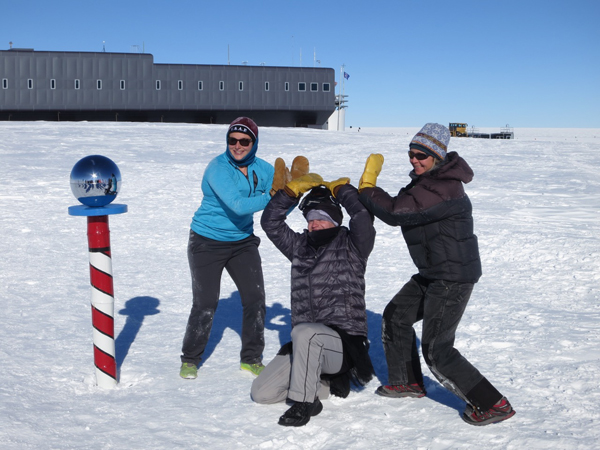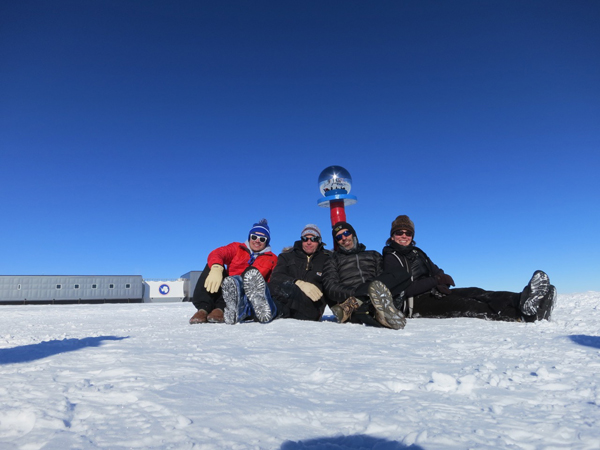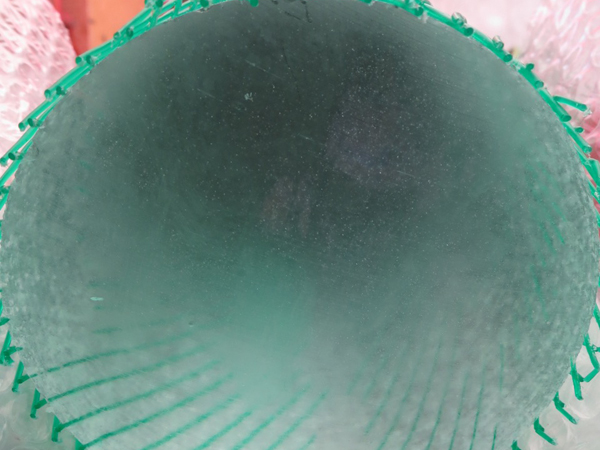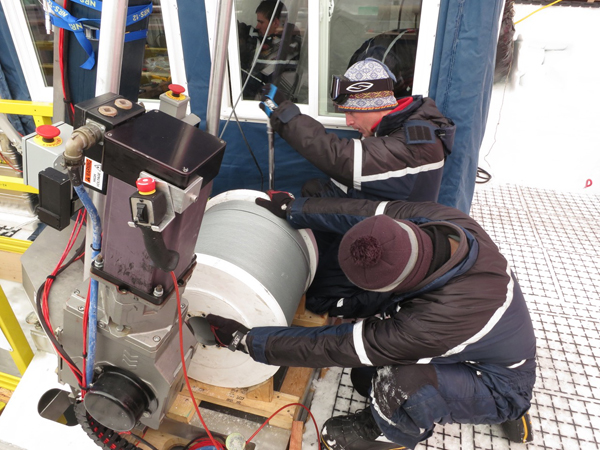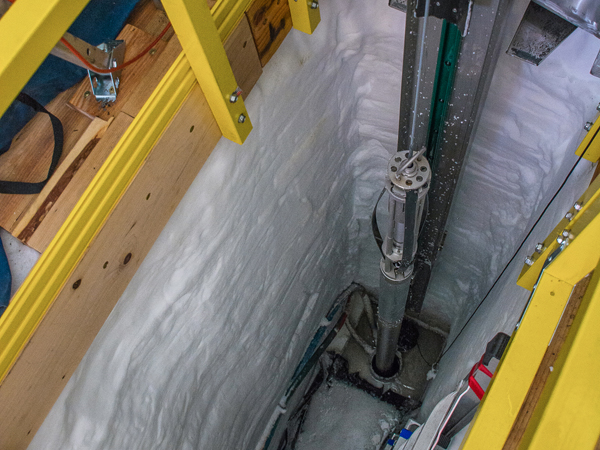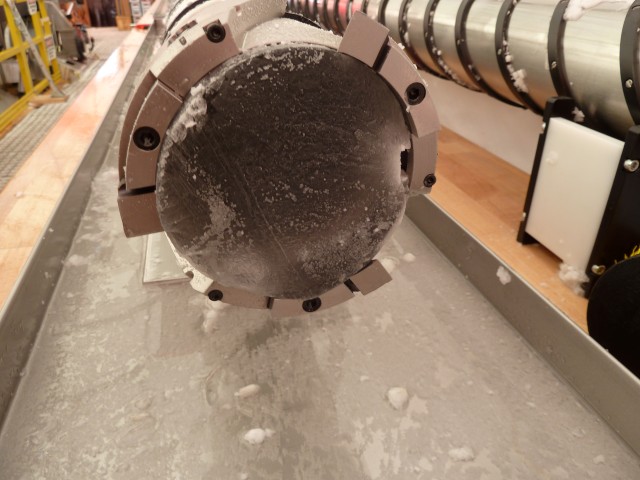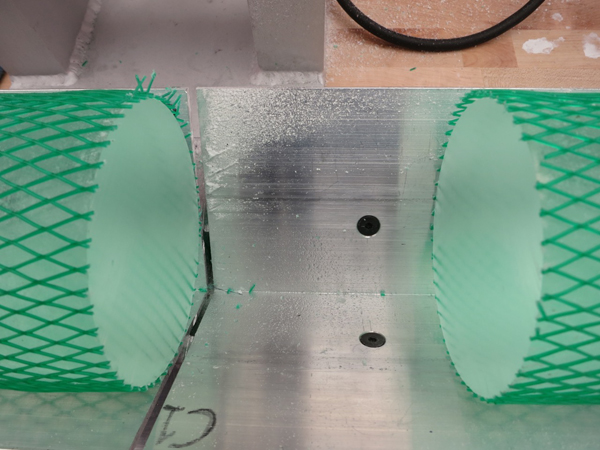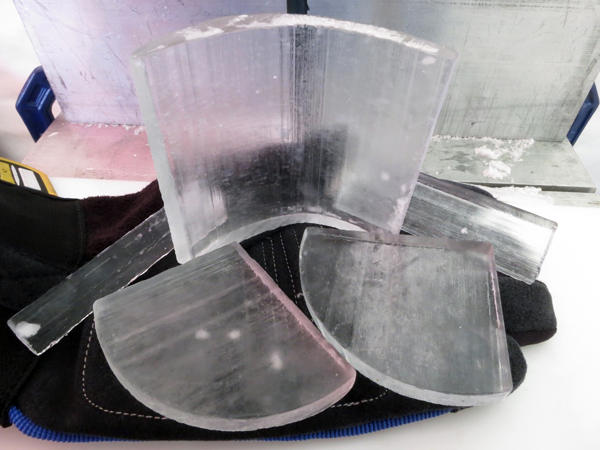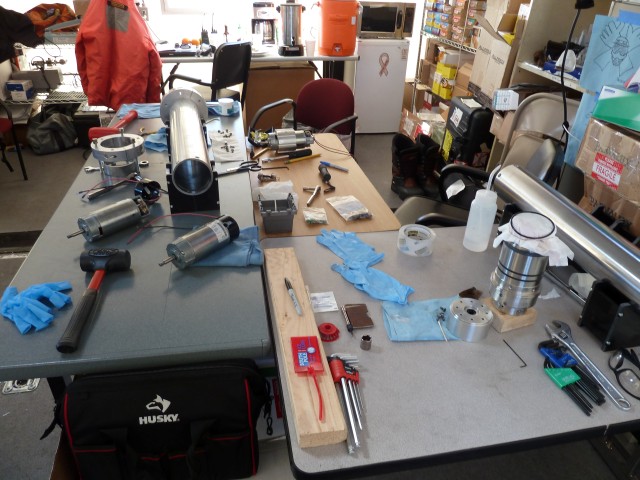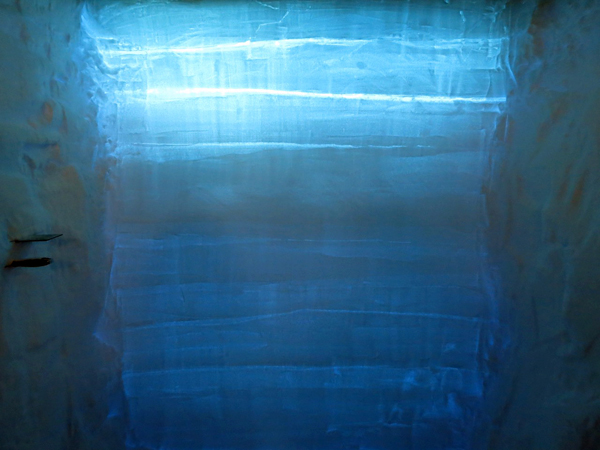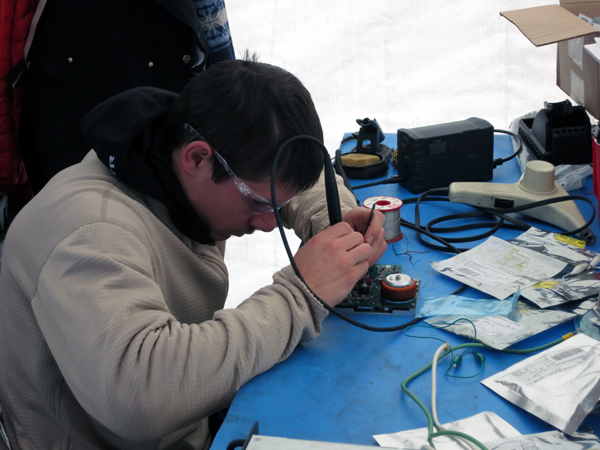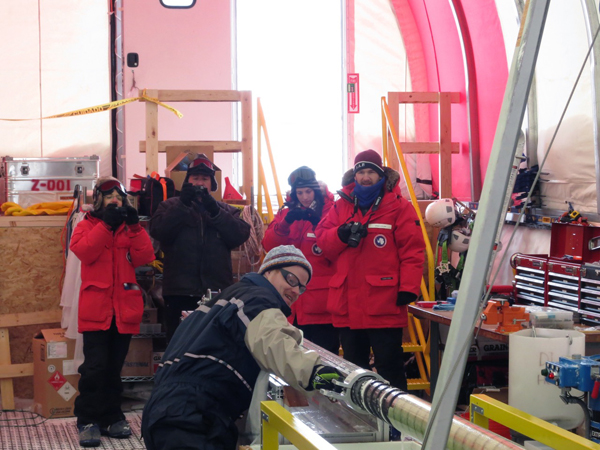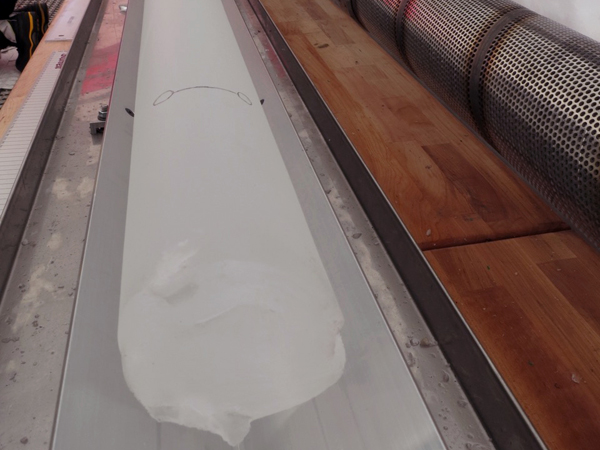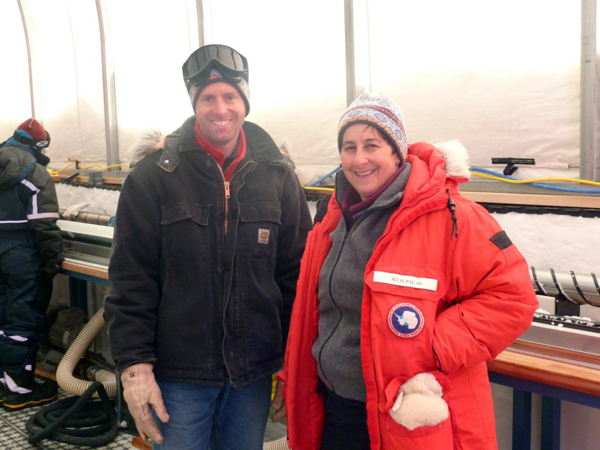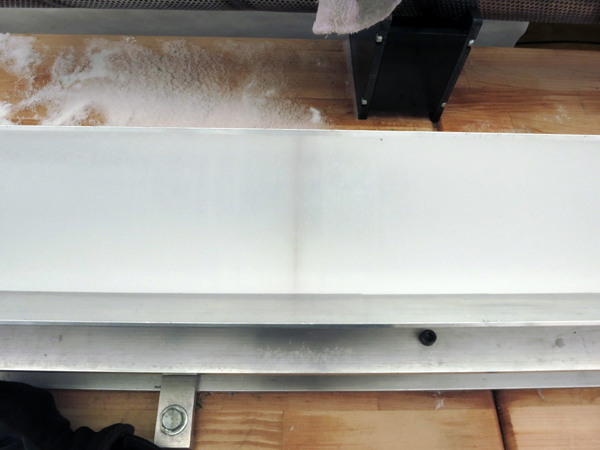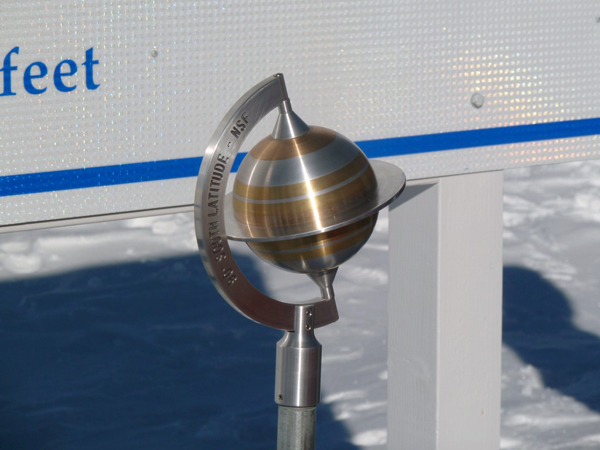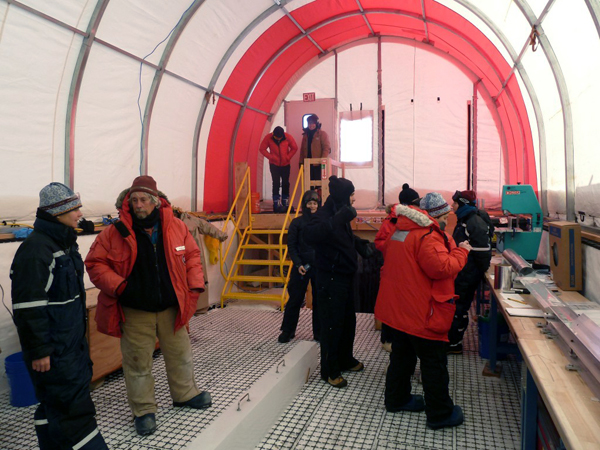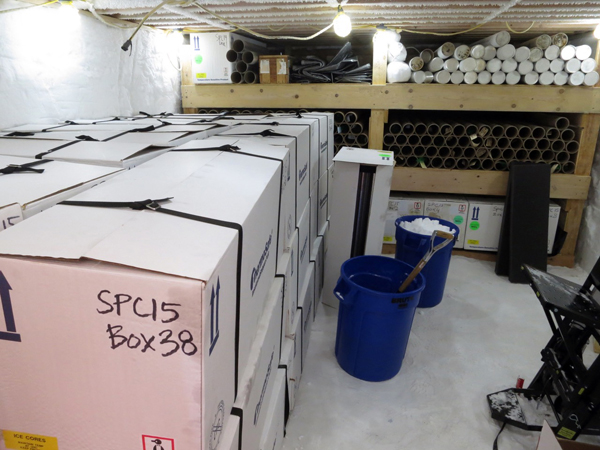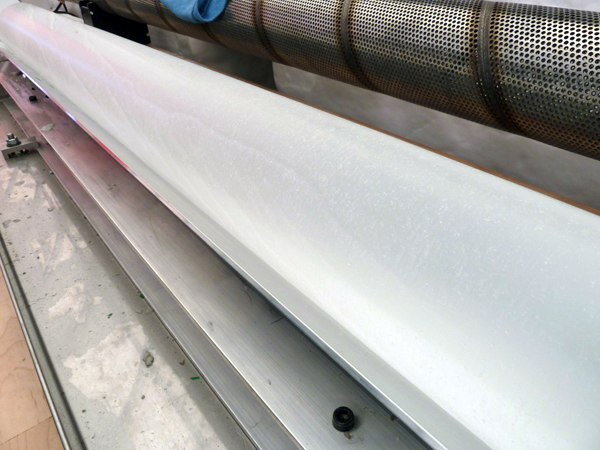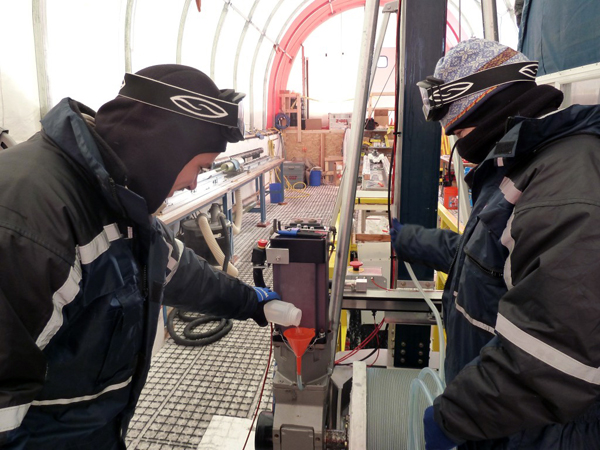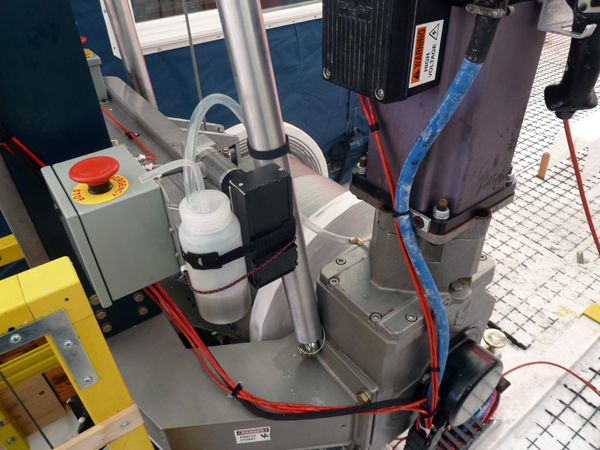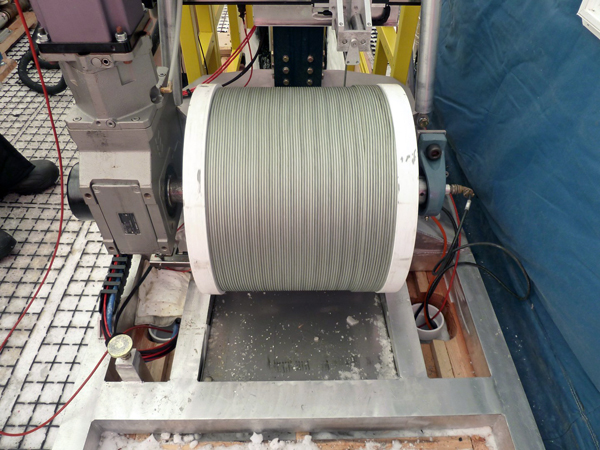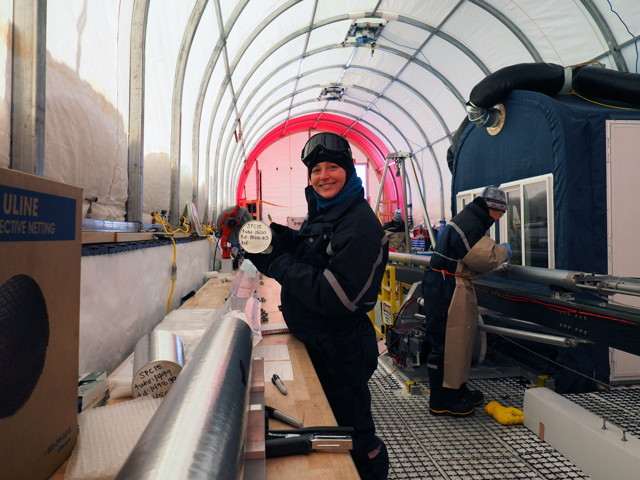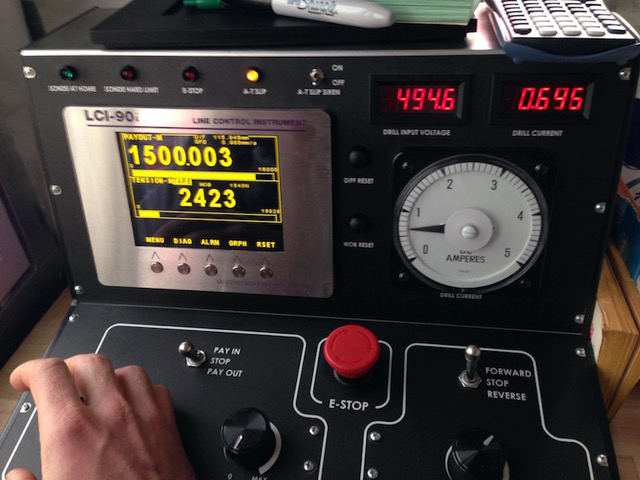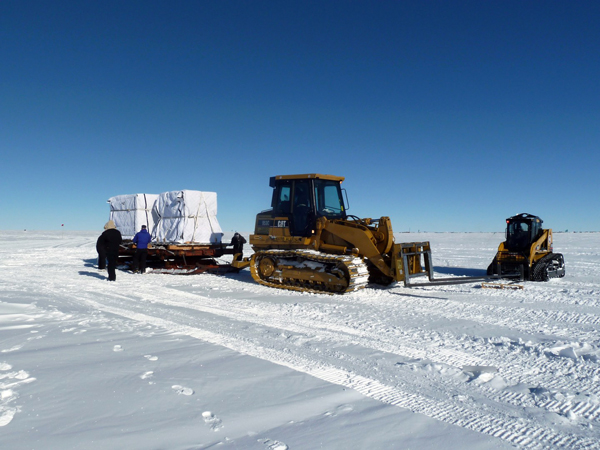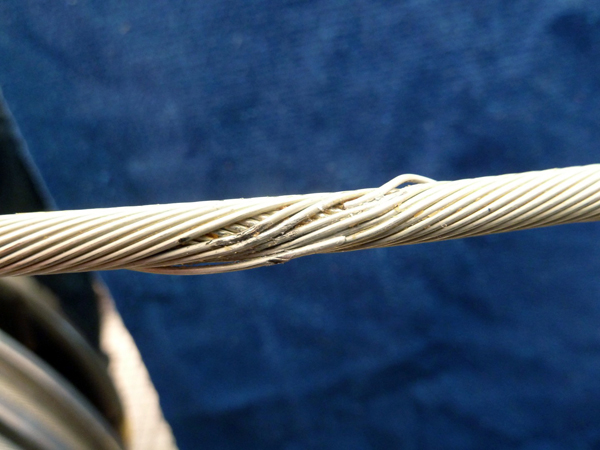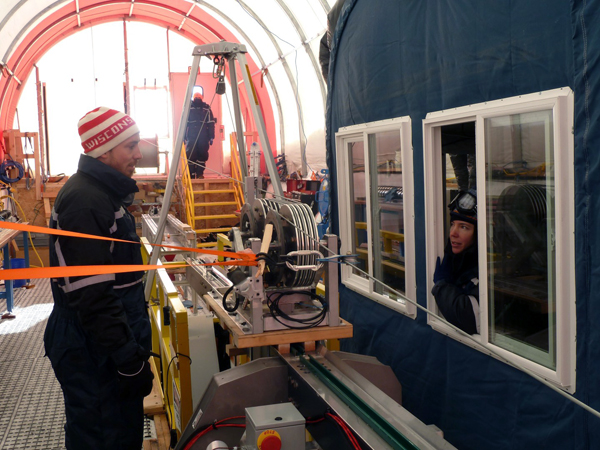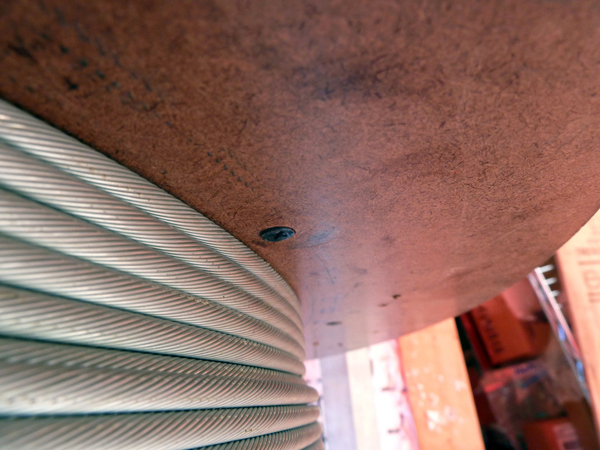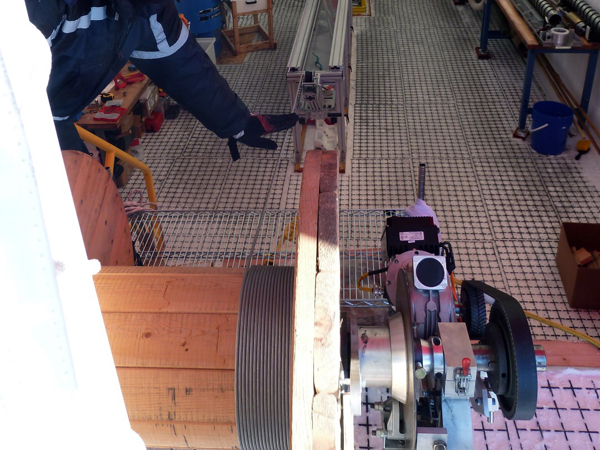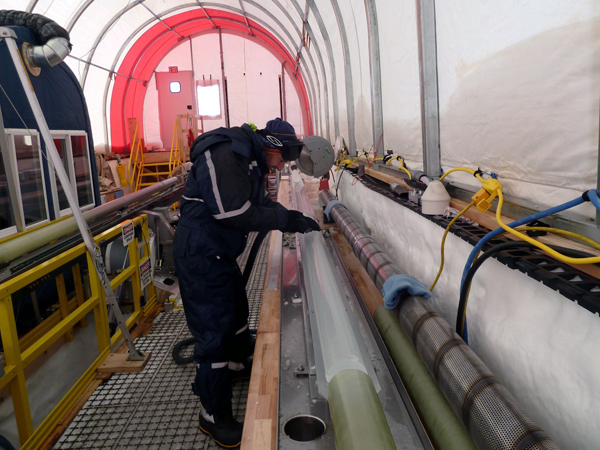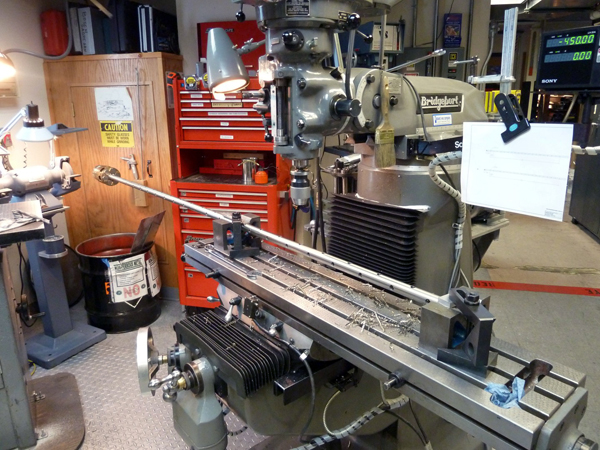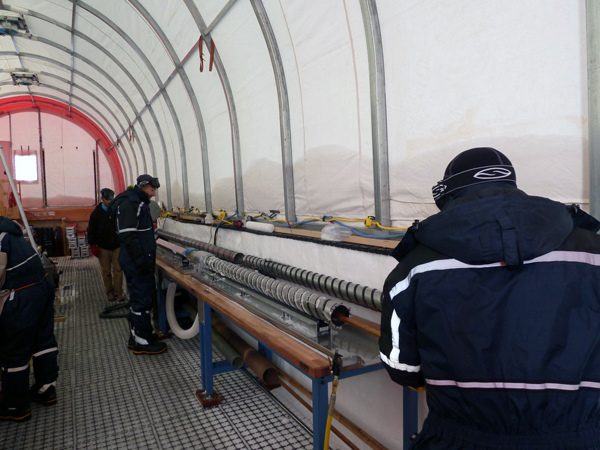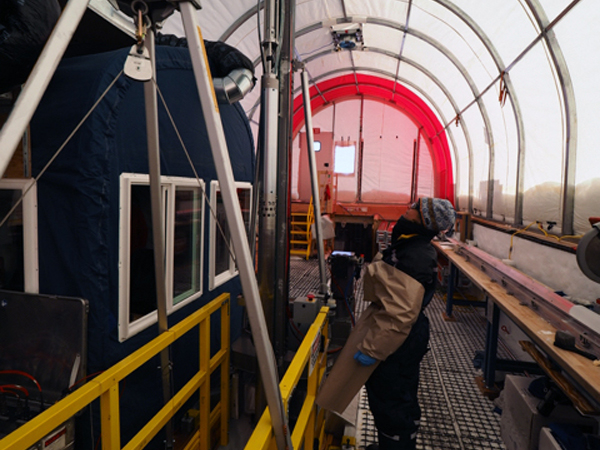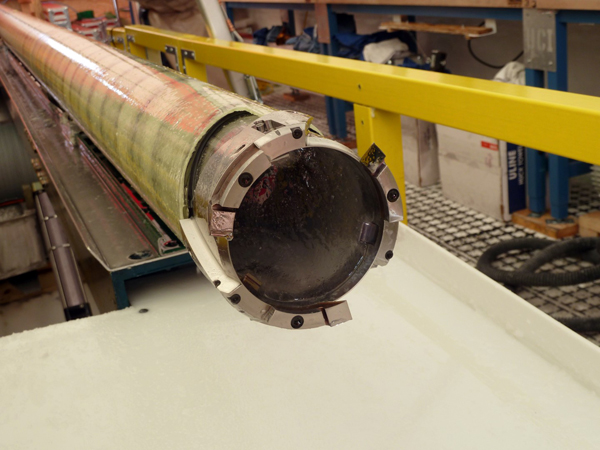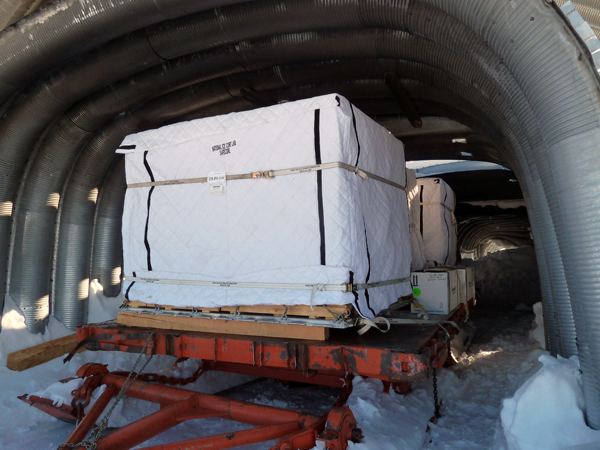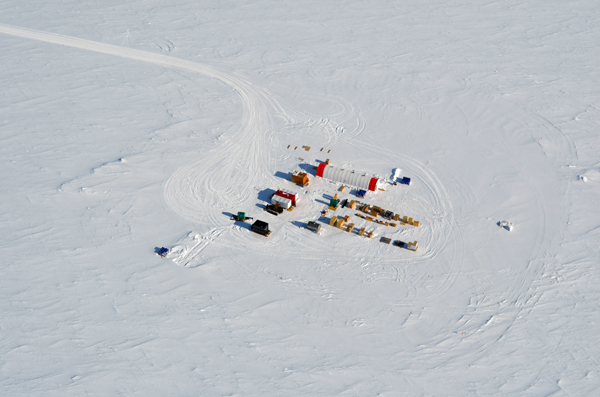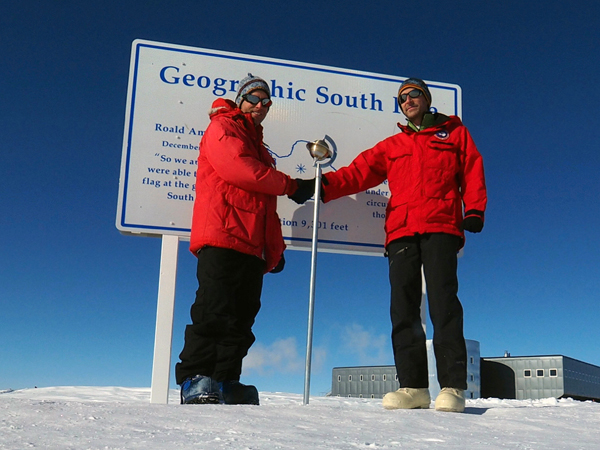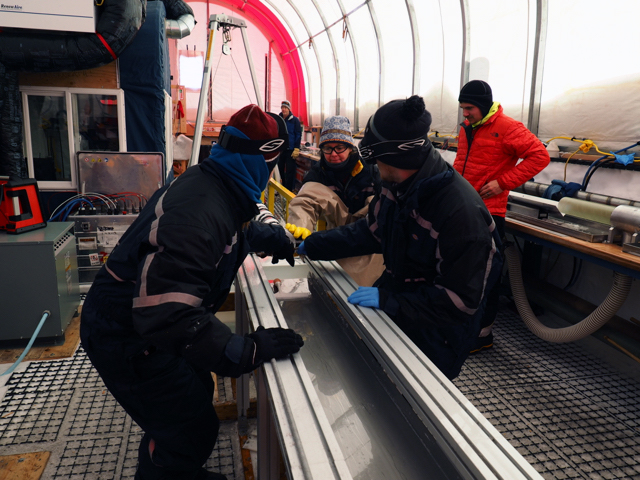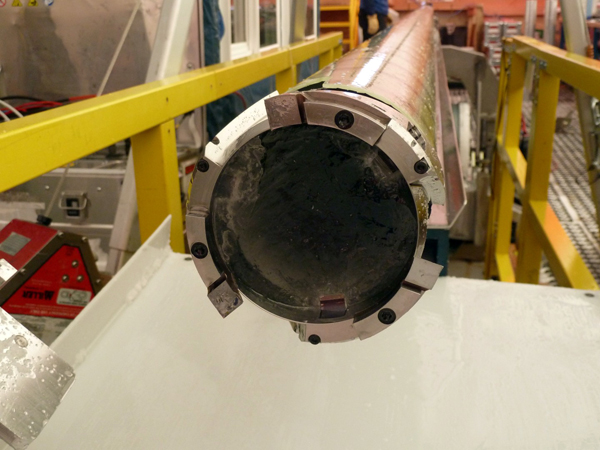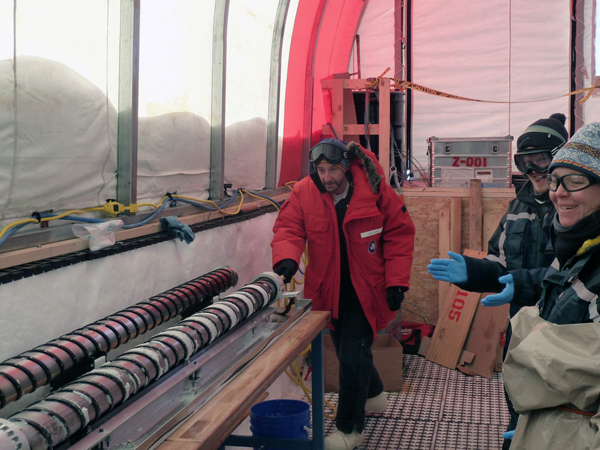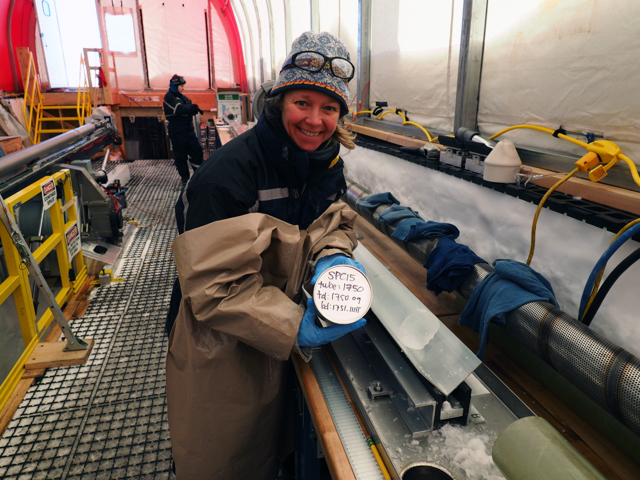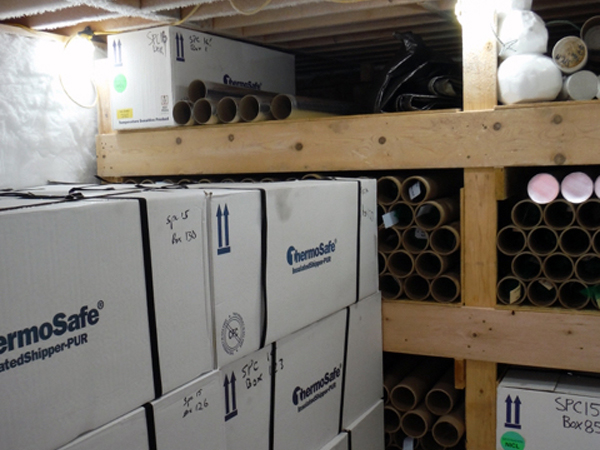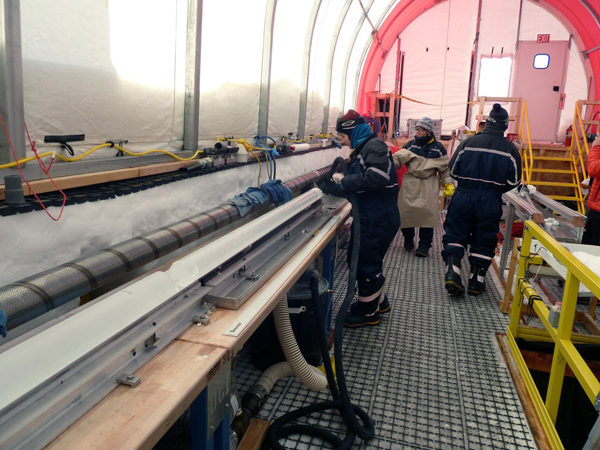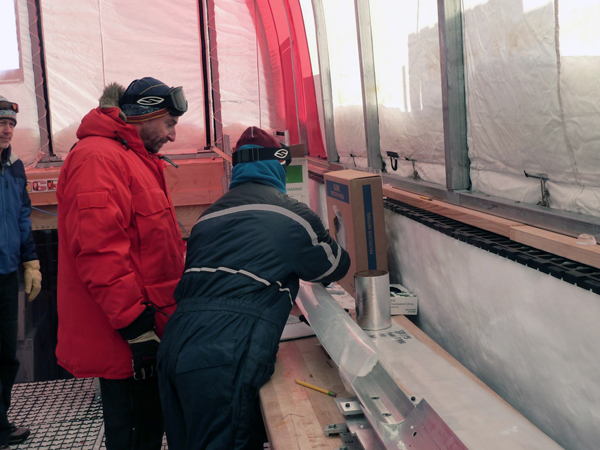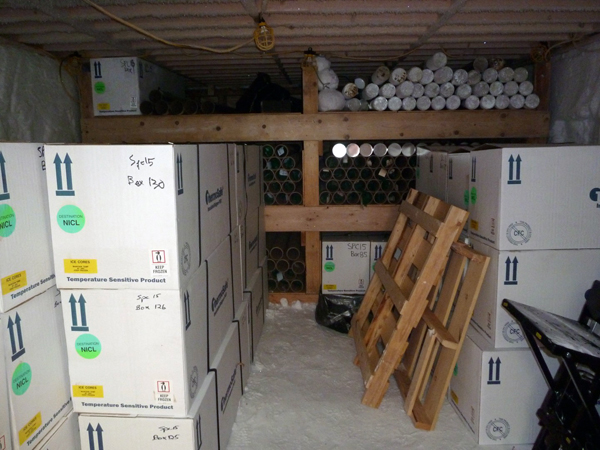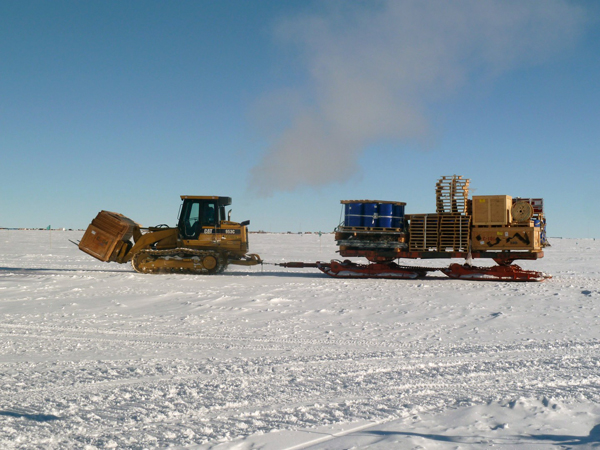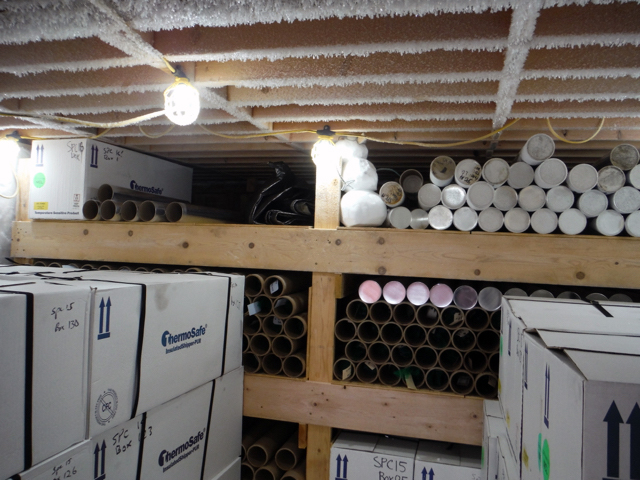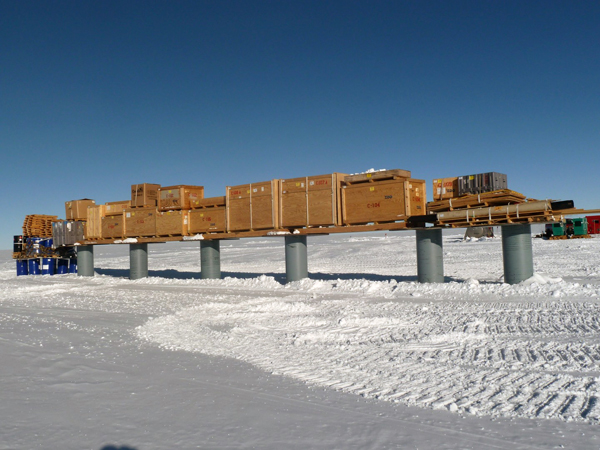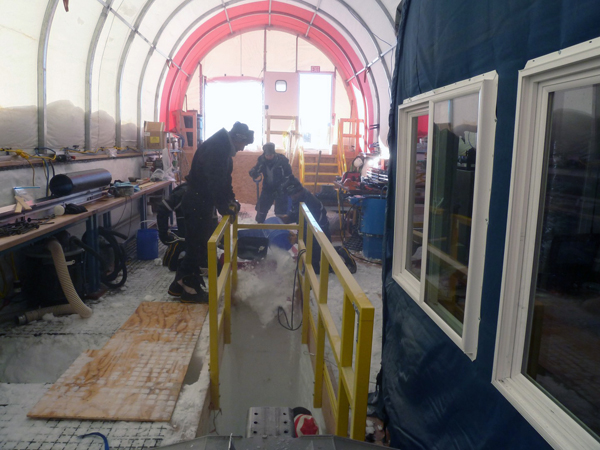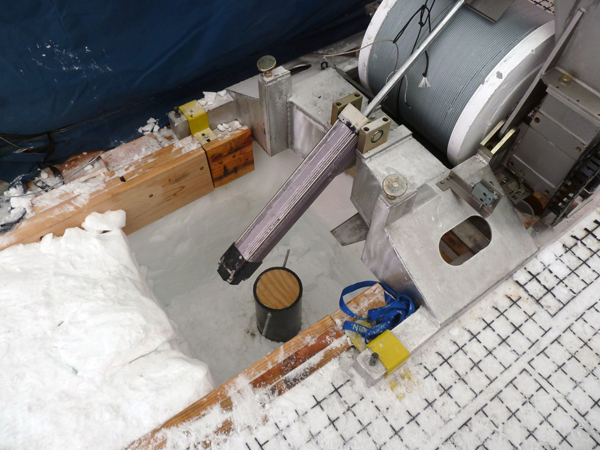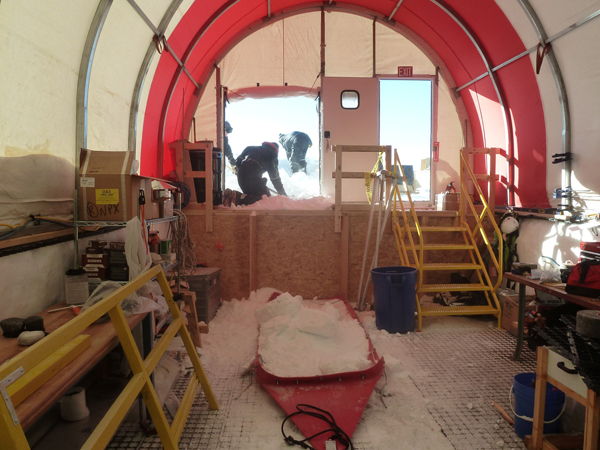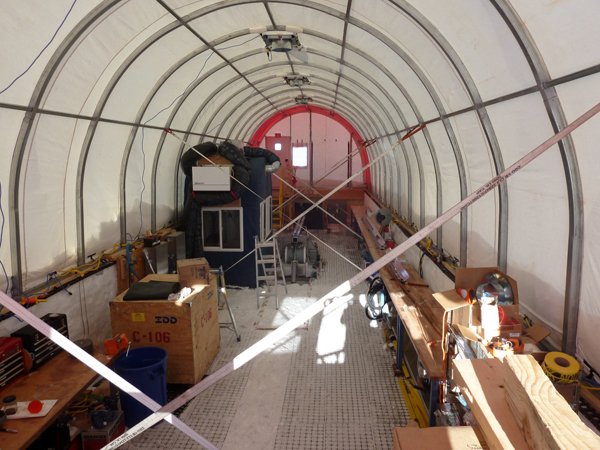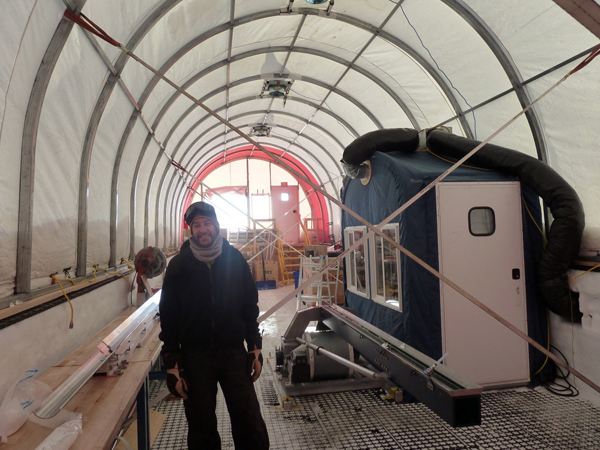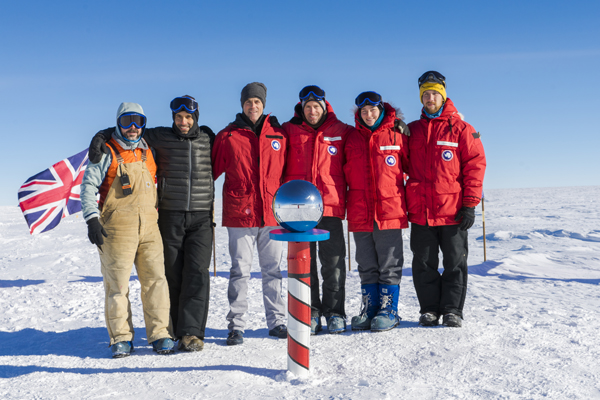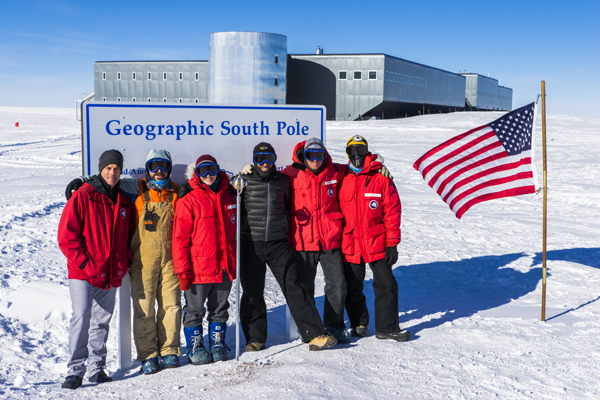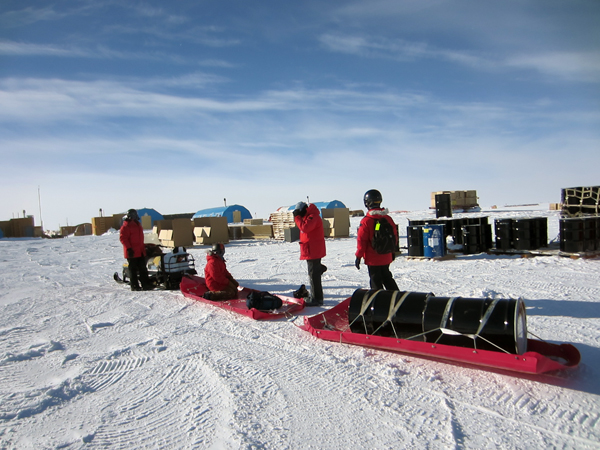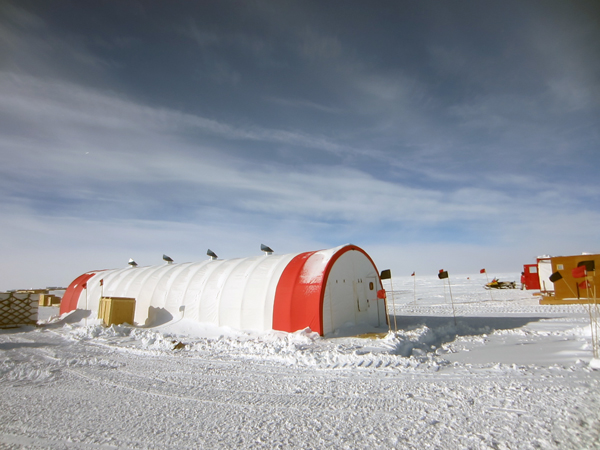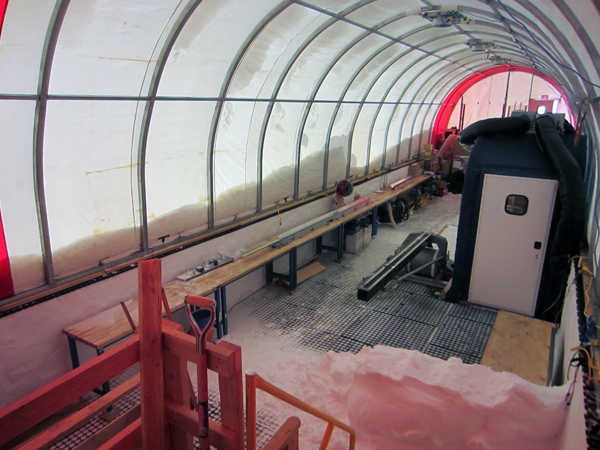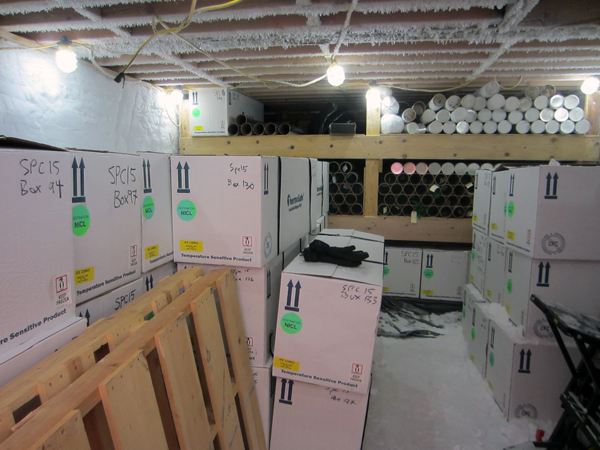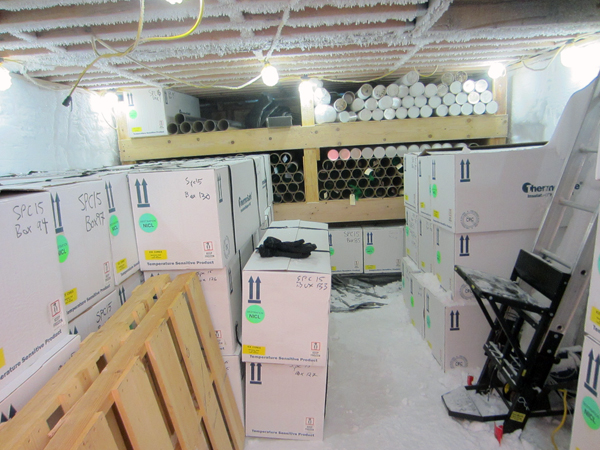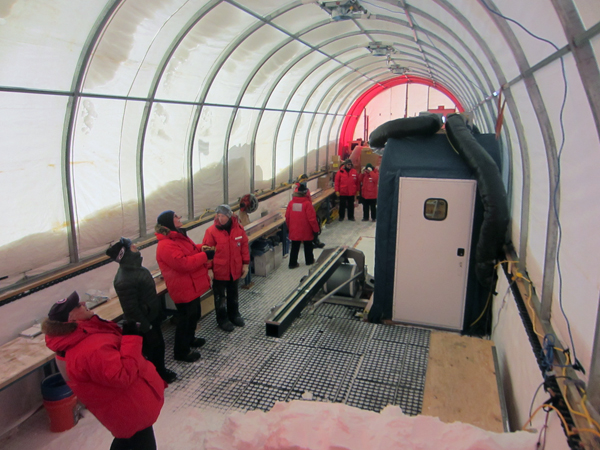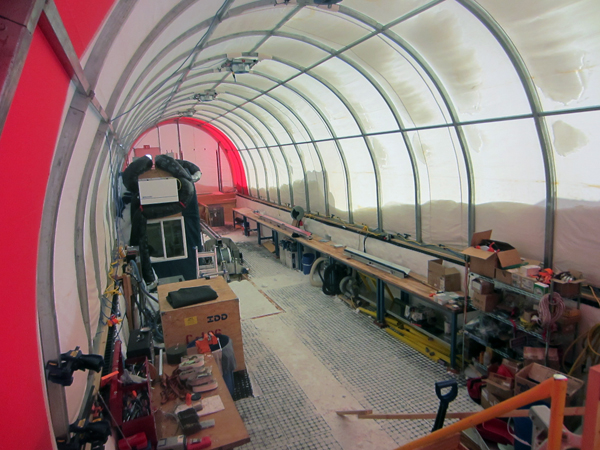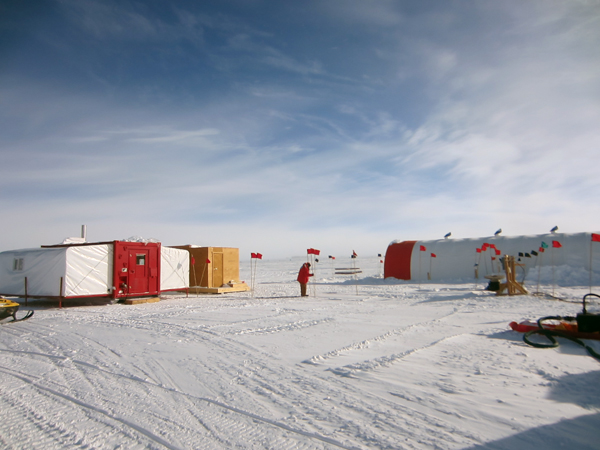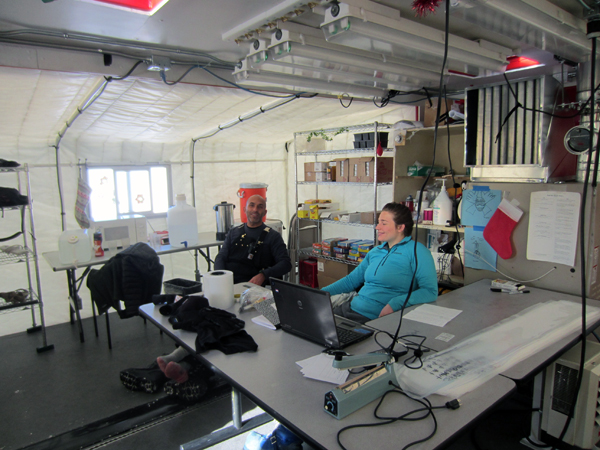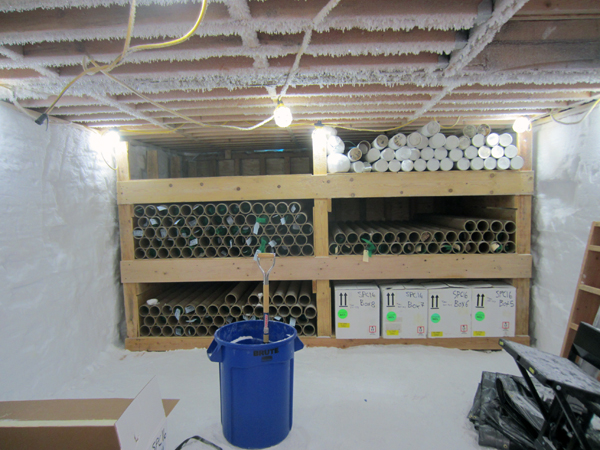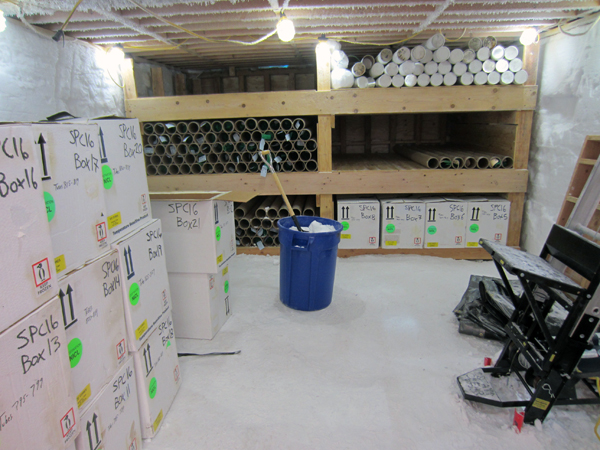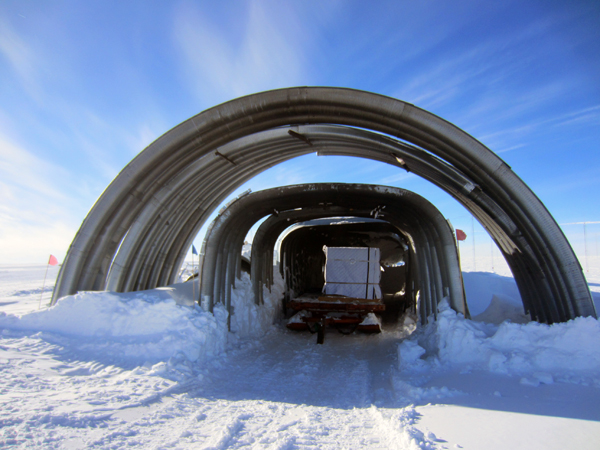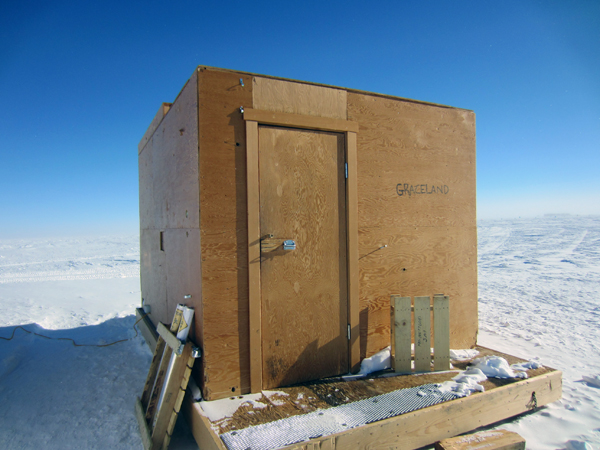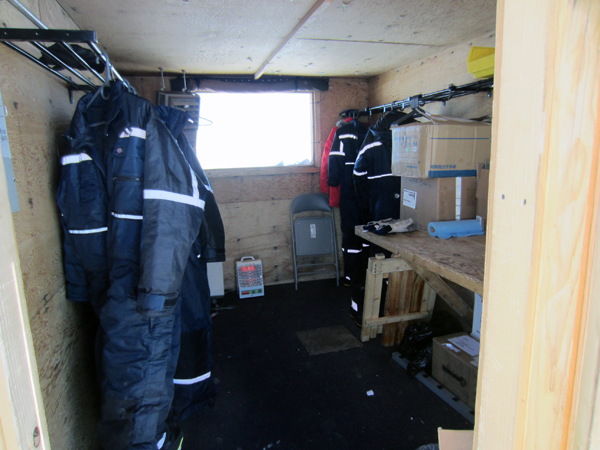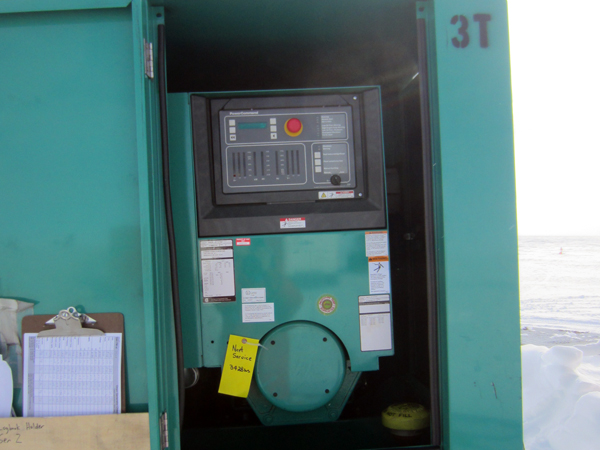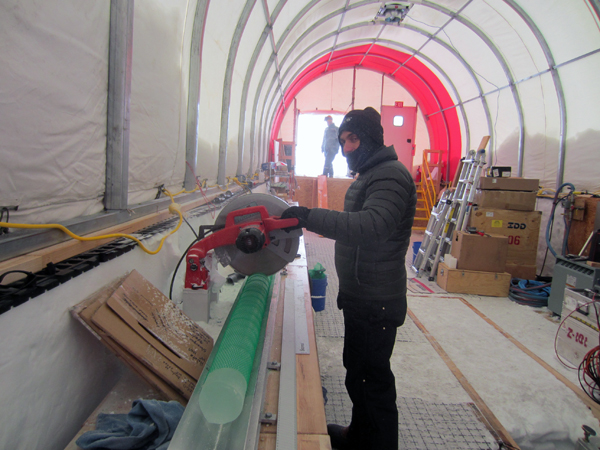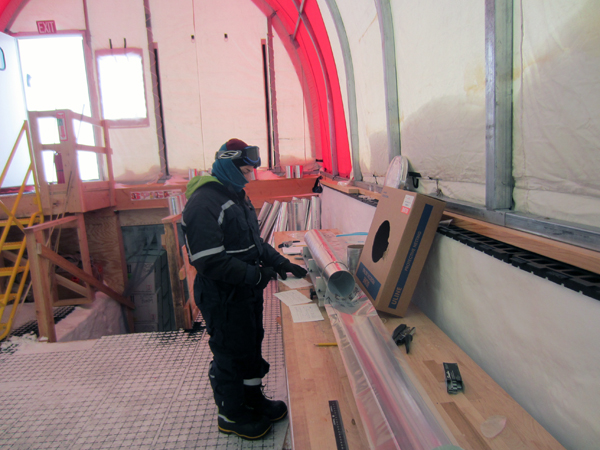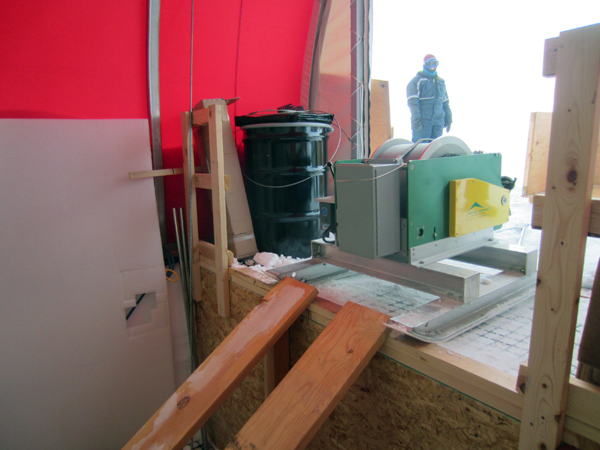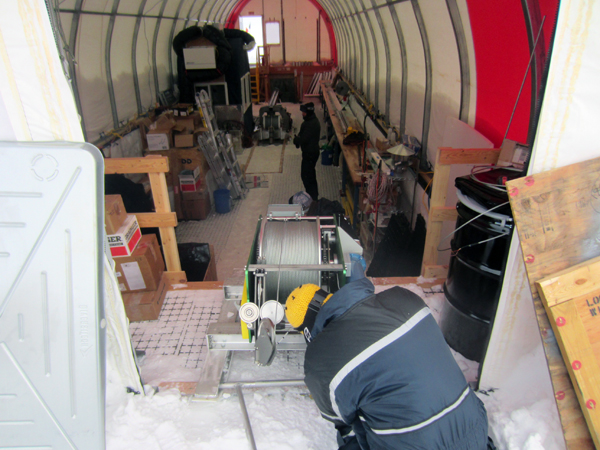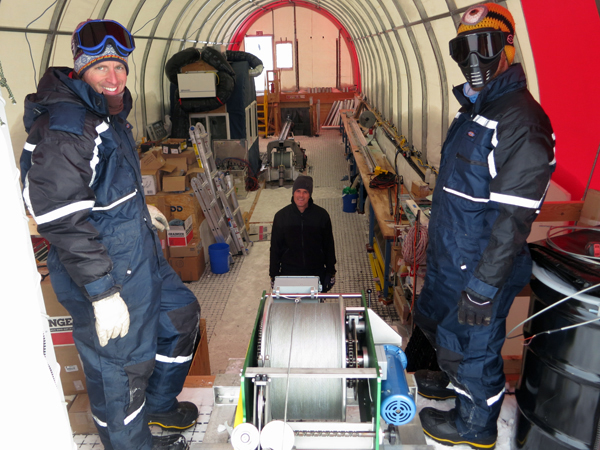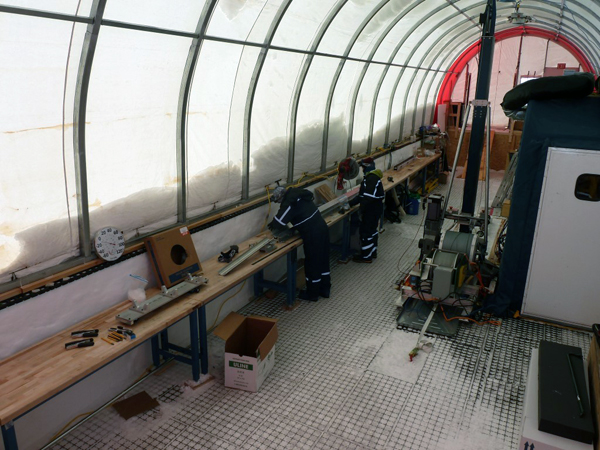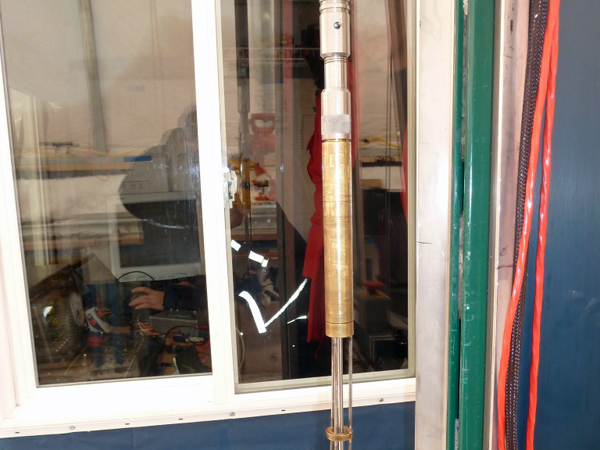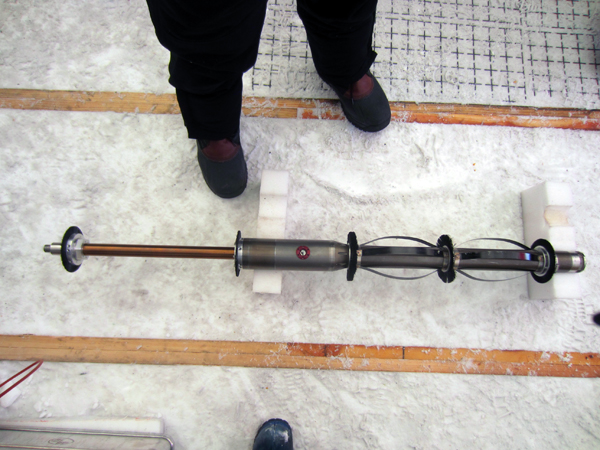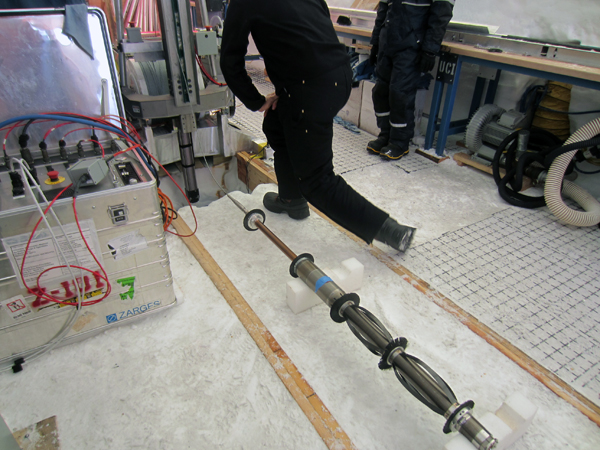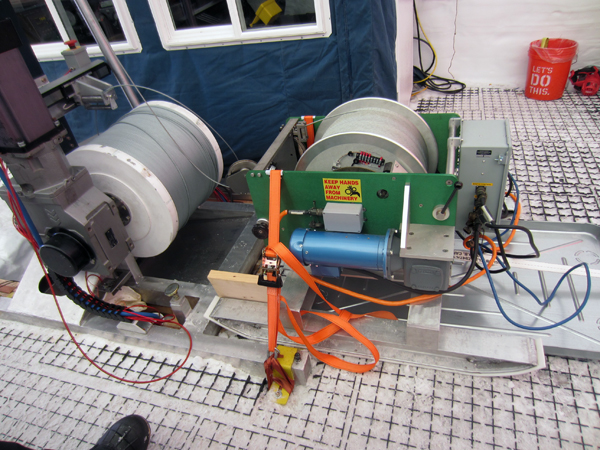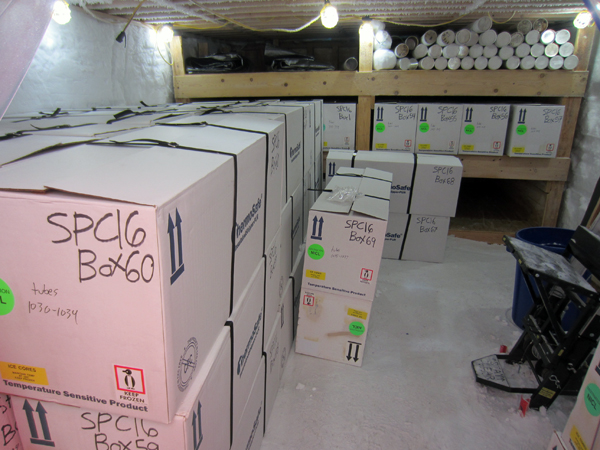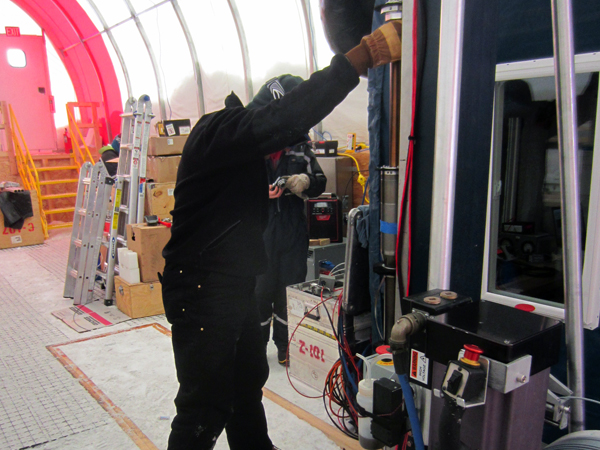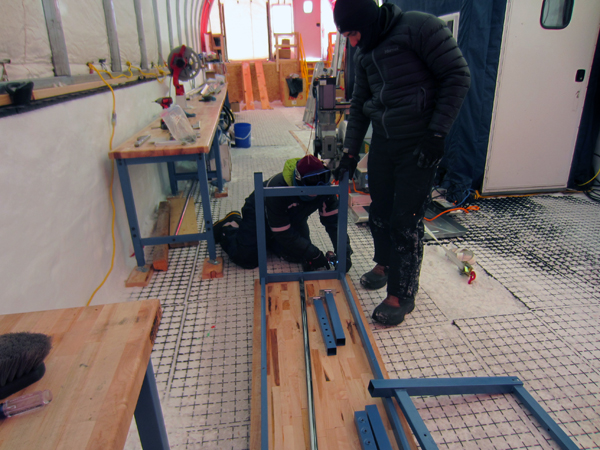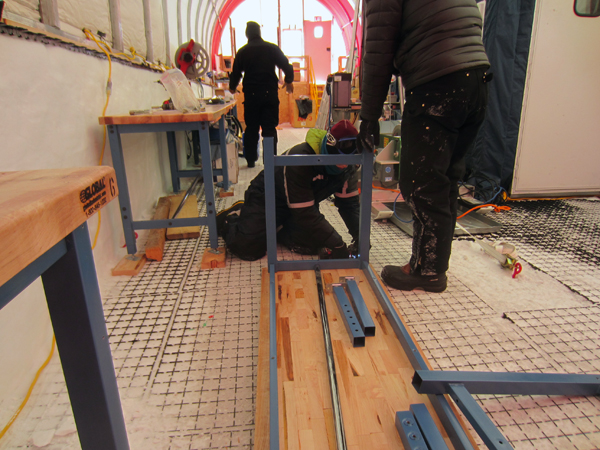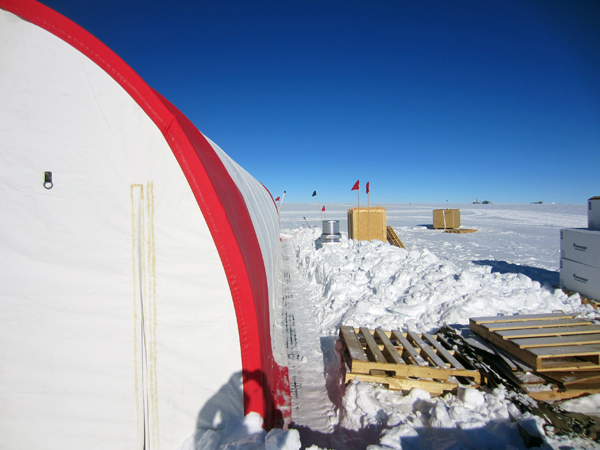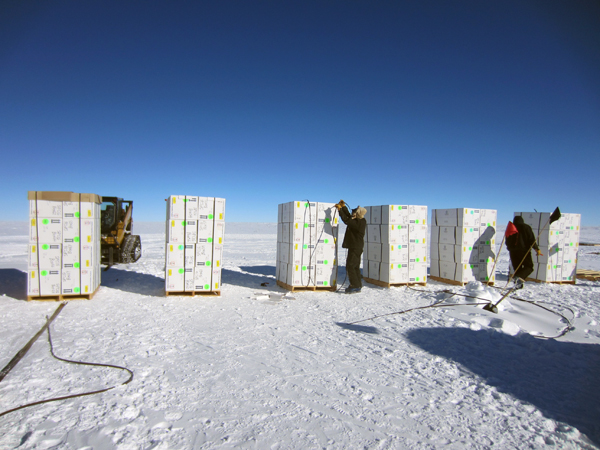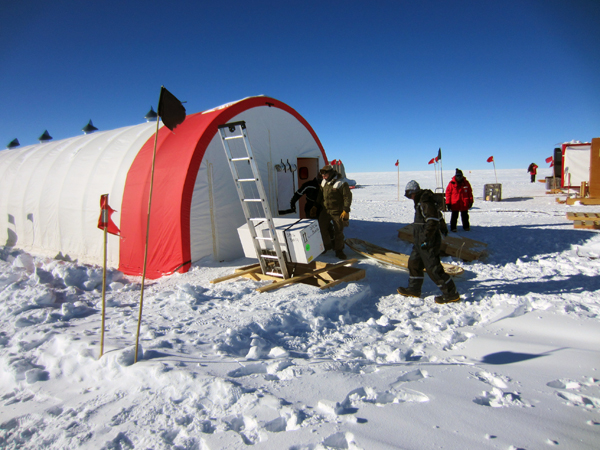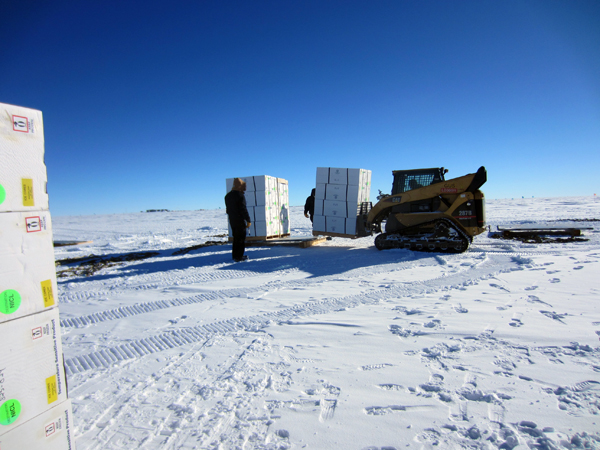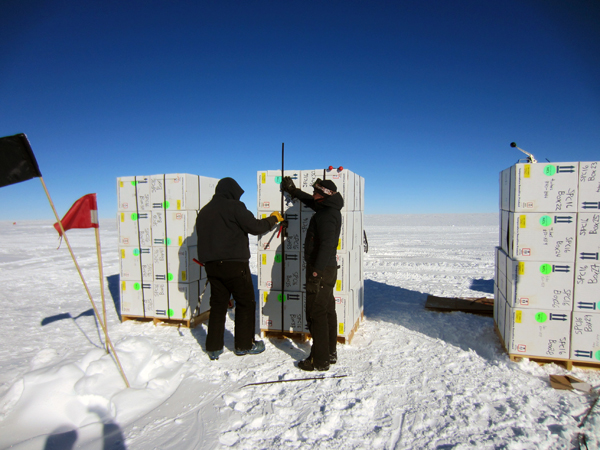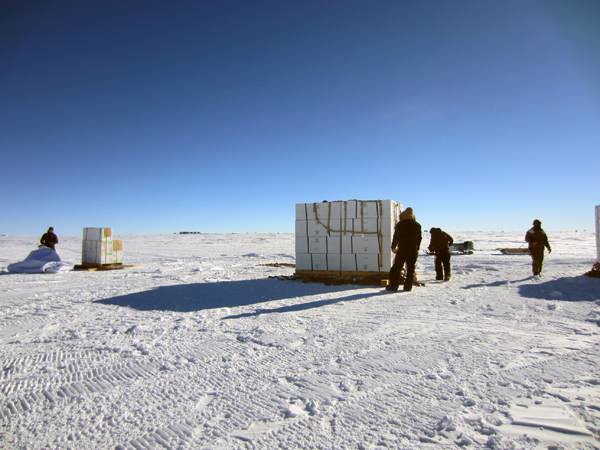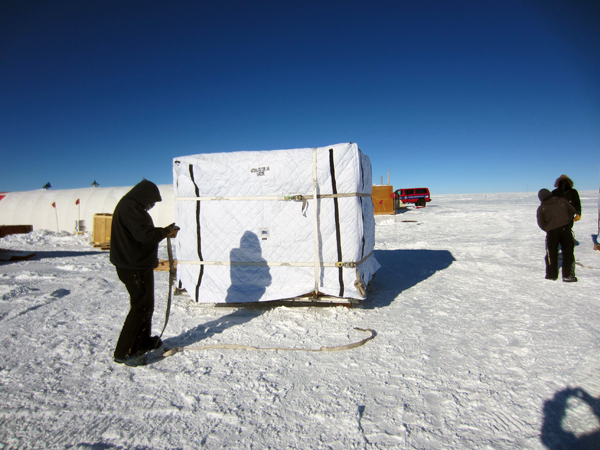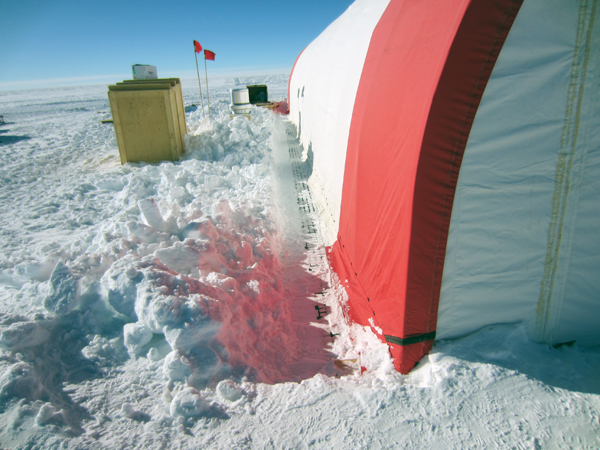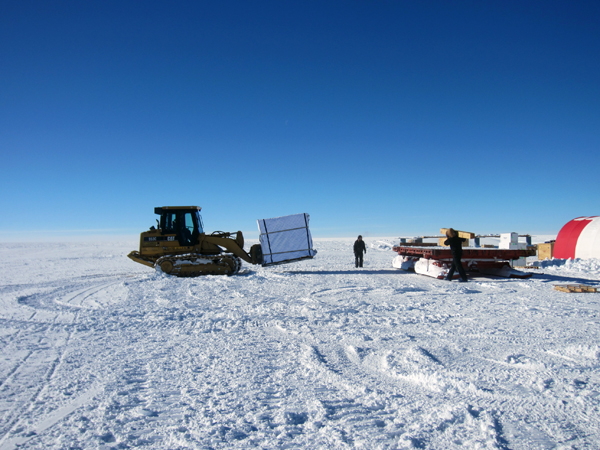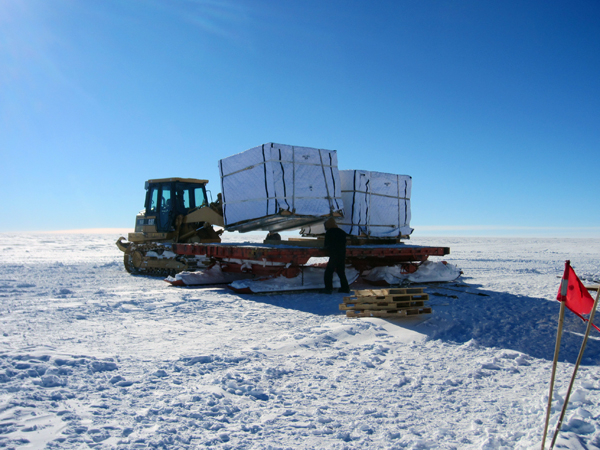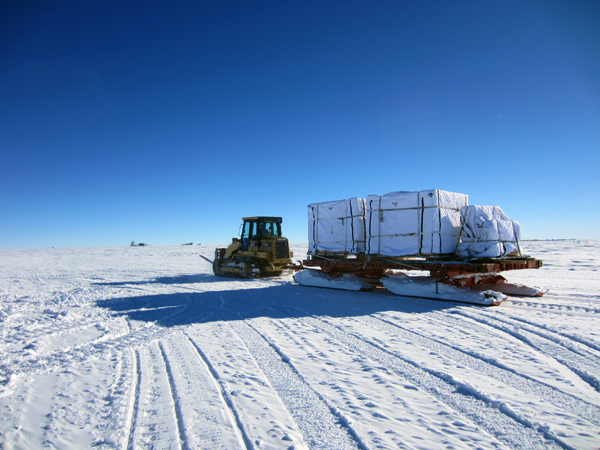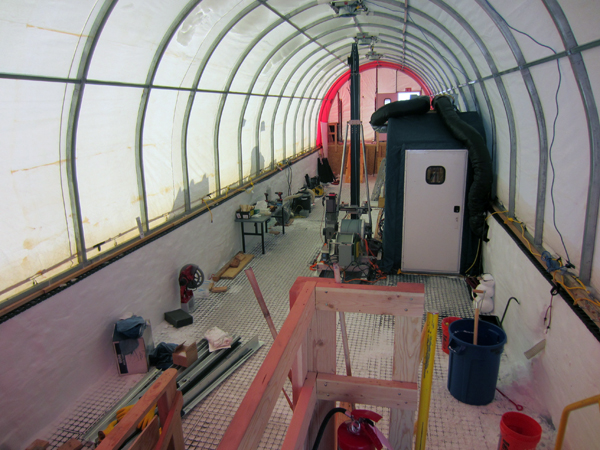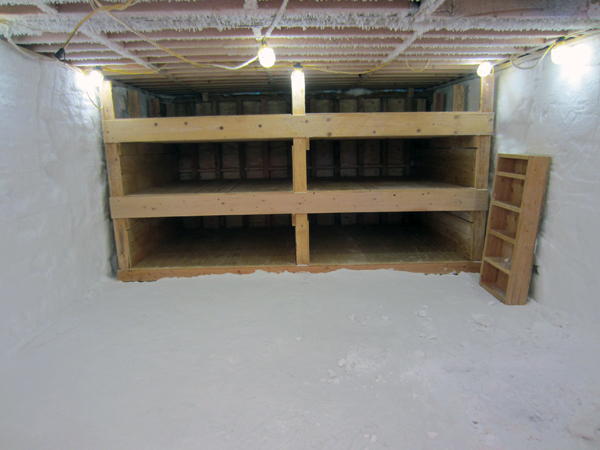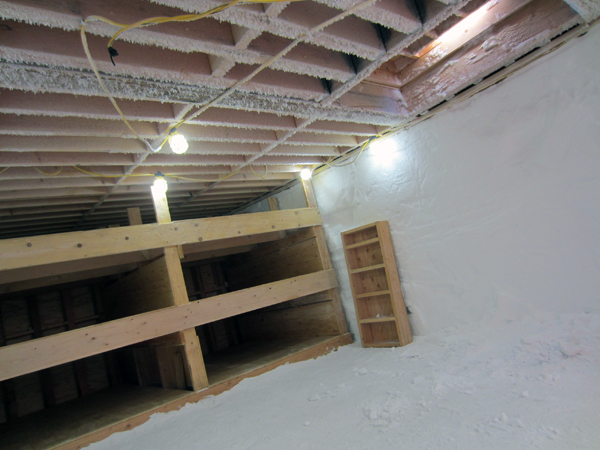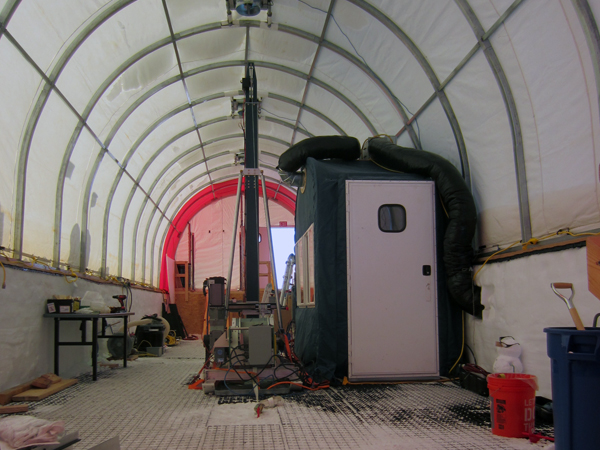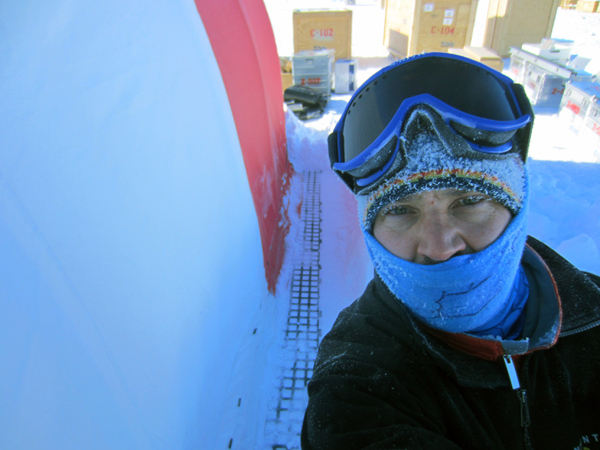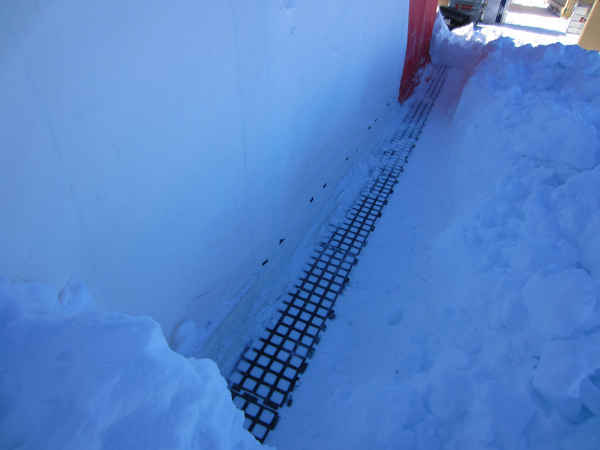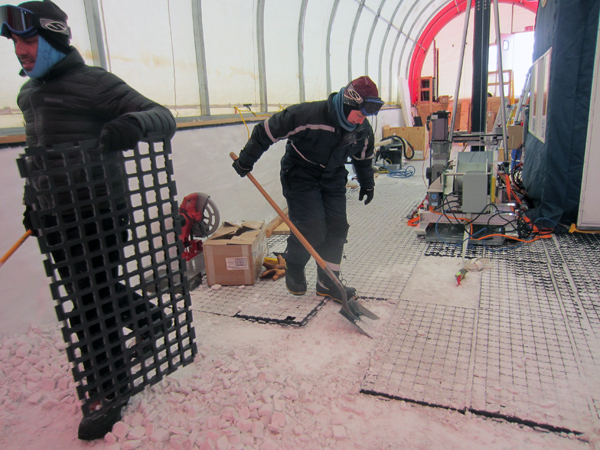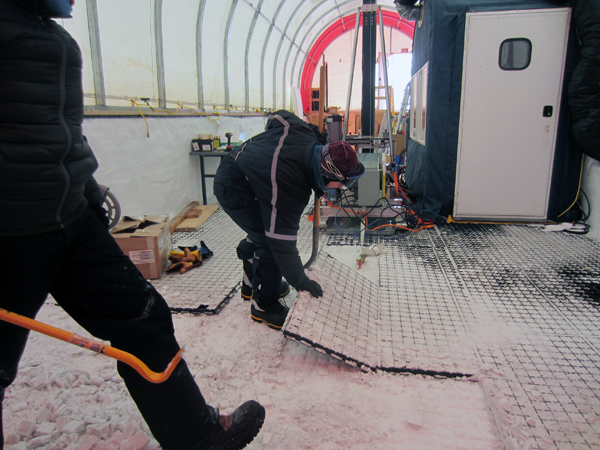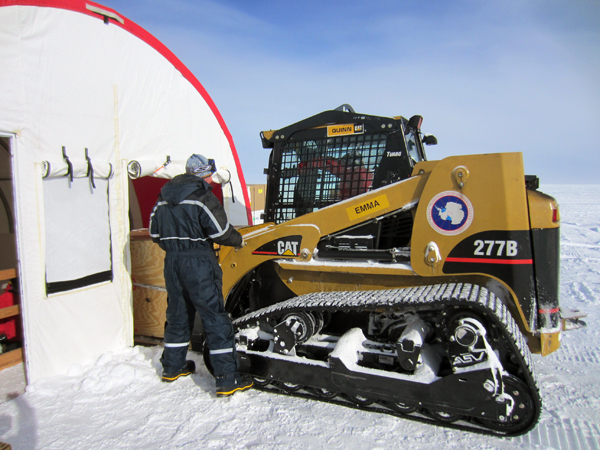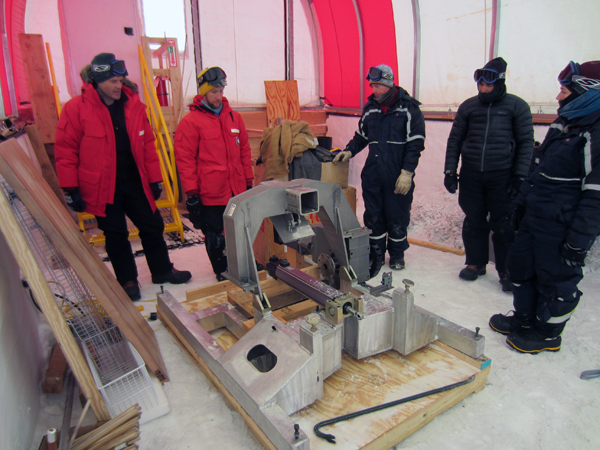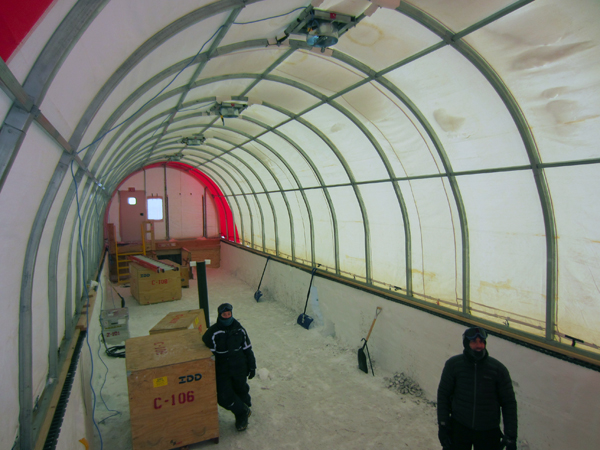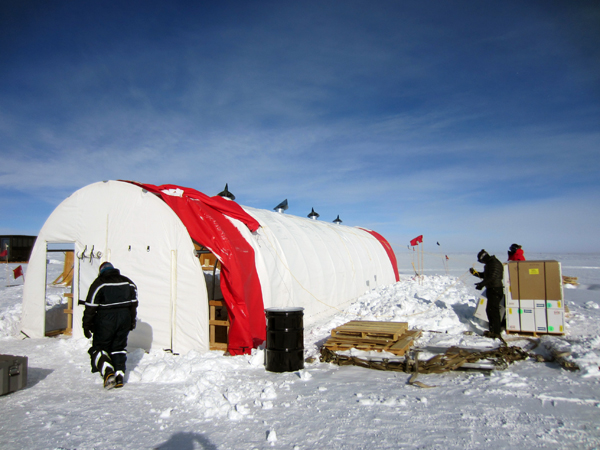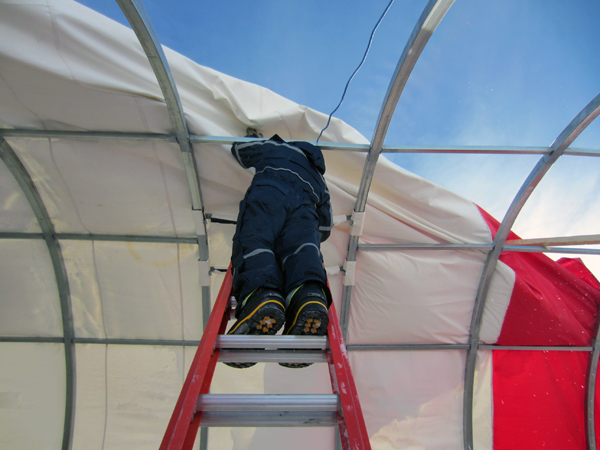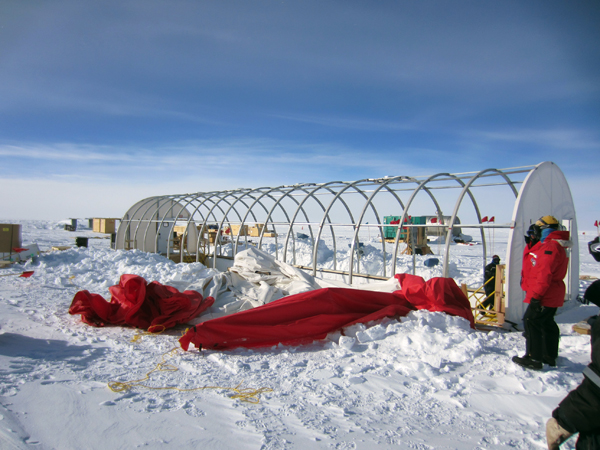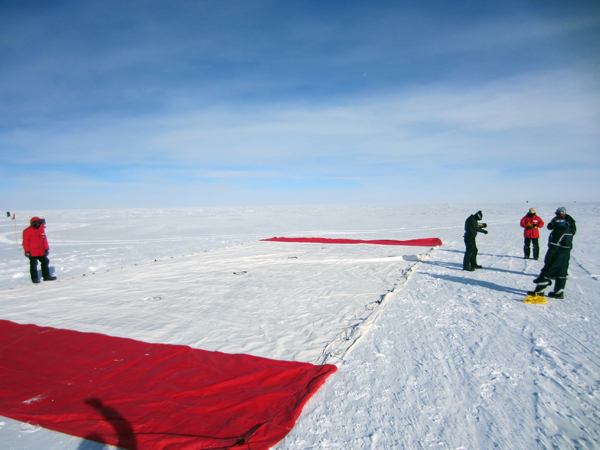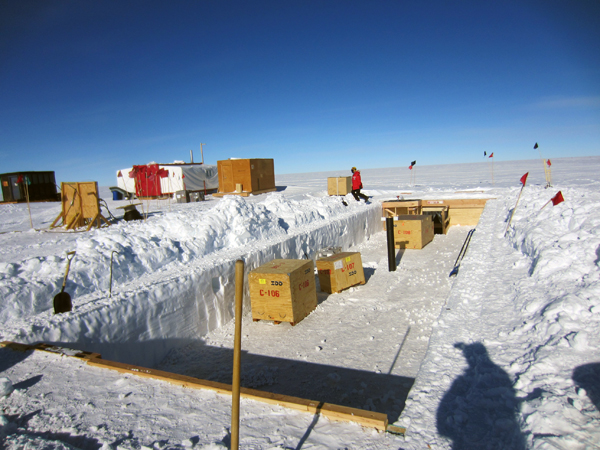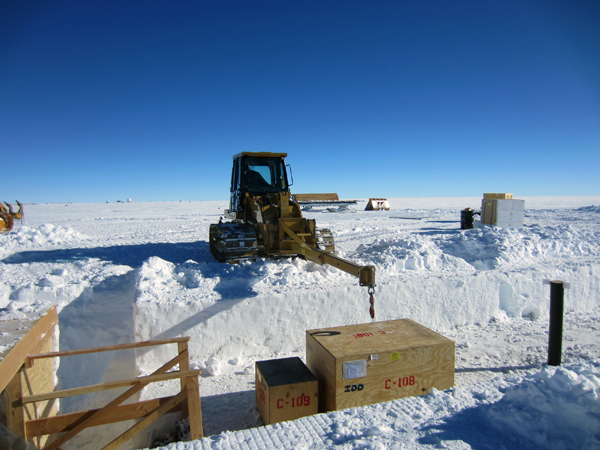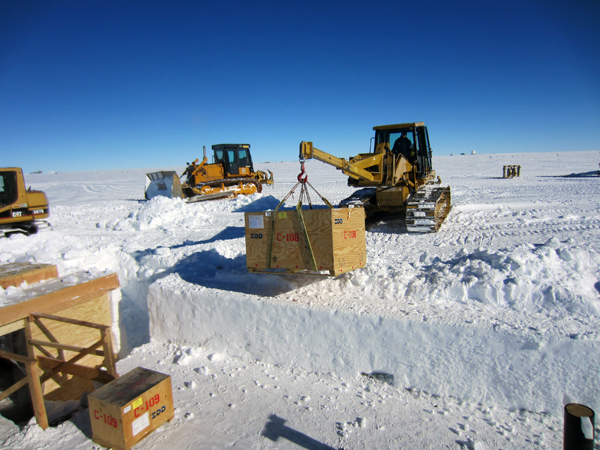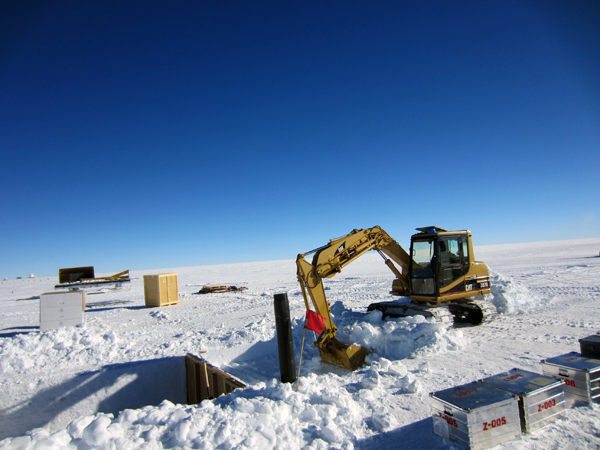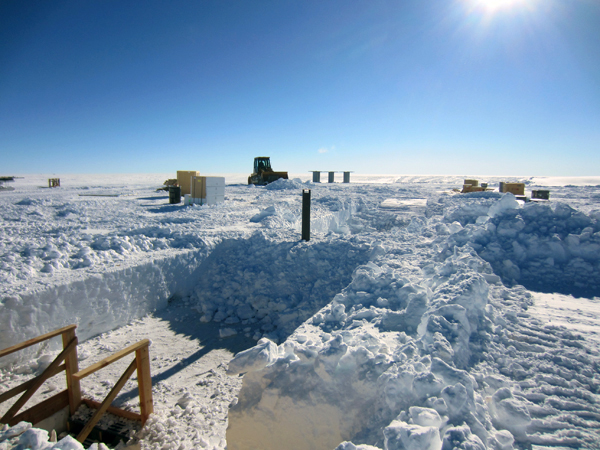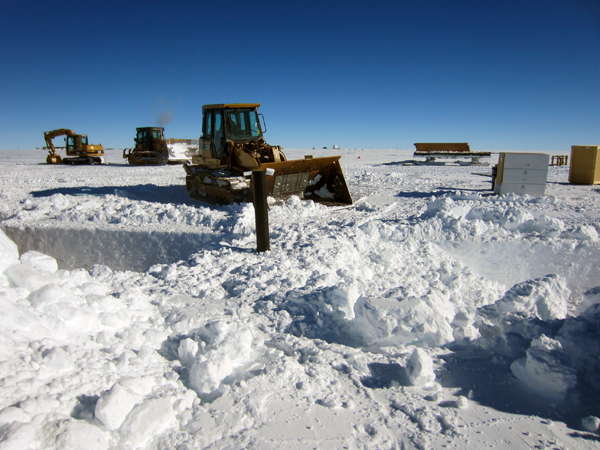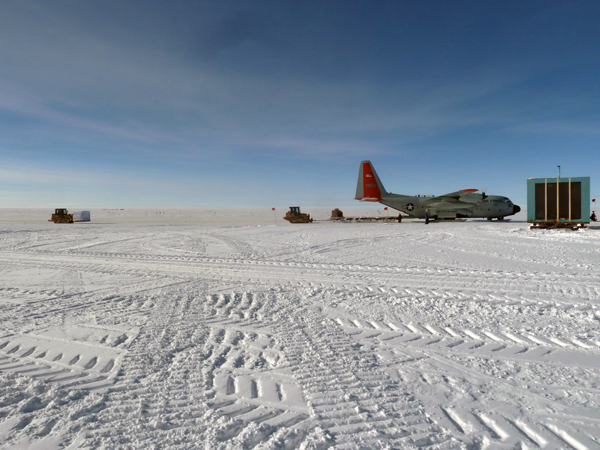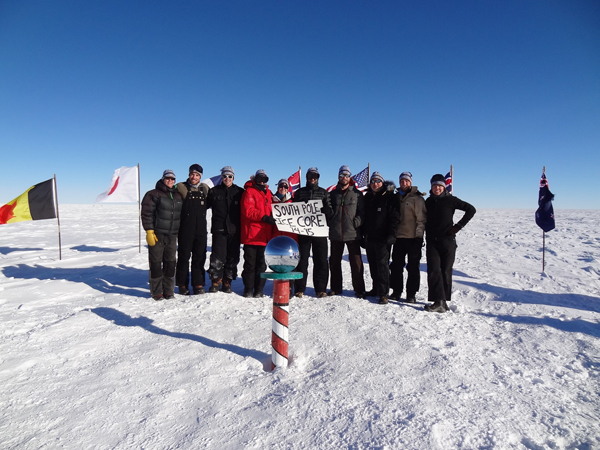
The 2014-15 South Pole ice core field team at the Ceremonial South Pole. (L to R): Elizabeth Morton, Grant Boeckmann, Nick Wipperfurth, Mindy Nicewonger, Kimberly Casey, Murat Aydin, Tanner Kuhl, Dave Ferris, Josh Goetz and Shawntel Singleton. Photo credit: Dave Ferris. Date taken: November 21, 2014
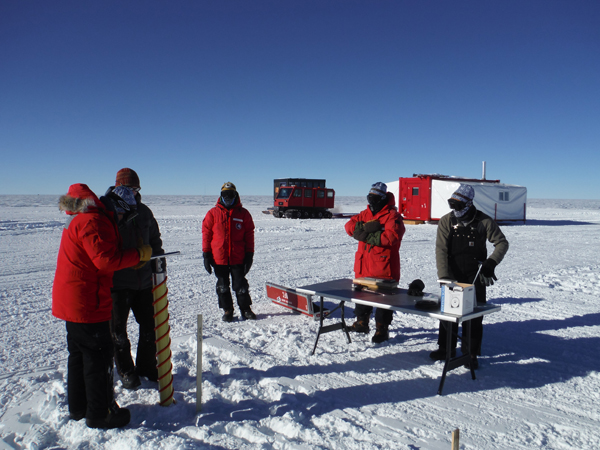
Drilling one of six shallow cores at the drill site. The purpose of the shallow cores is to measure the snow density at the drill site to make sure that it is adequate for the overlying drill structure. Pictured (L to R) are Elizabeth Morton, Tanner Kuhl, Josh Goetz, Nick Wipperfurth and Grant Boeckman. Photo credit: Murat Aydin. Date taken: November 19, 2014.
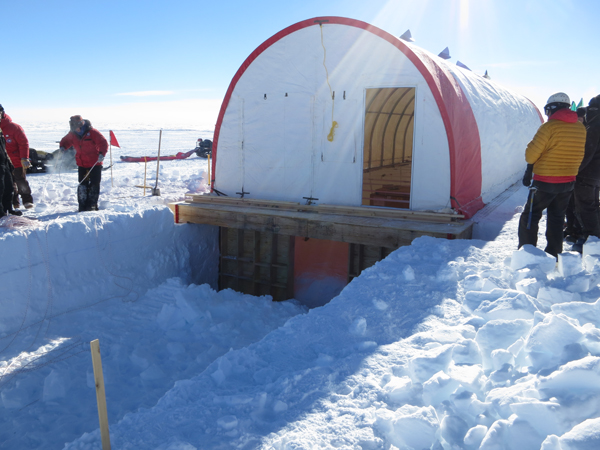
Pulling the WeatherPort tent over the drilling trench. The WeatherPort houses the drilling and core handling operations. The WeatherPort tent is 19.5m L x 4.9m W x 2.8m H (64' x 16' x 9') and covers a trench that is approximately 15m L x 4.6m W x 1.5m D (49' x 15' x 4.9'). Photo credit: Murat Aydin. Date taken: November 27, 2014
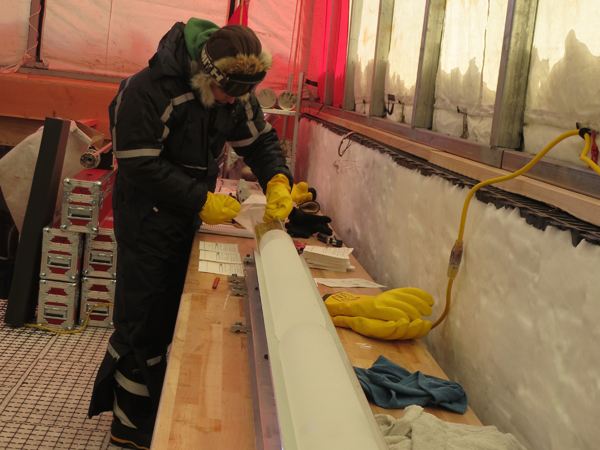
TJ Fudge places freshly-drilled ice cores into polyethylene ’layflat’ tubing. The cores are then placed into aluminum-coated cardboard core tubes, and the core tubes were then packed into insulated shipping container (ISC) boxes used by the US ice-coring community to transport ice cores. Photo credit: Murat Aydin.
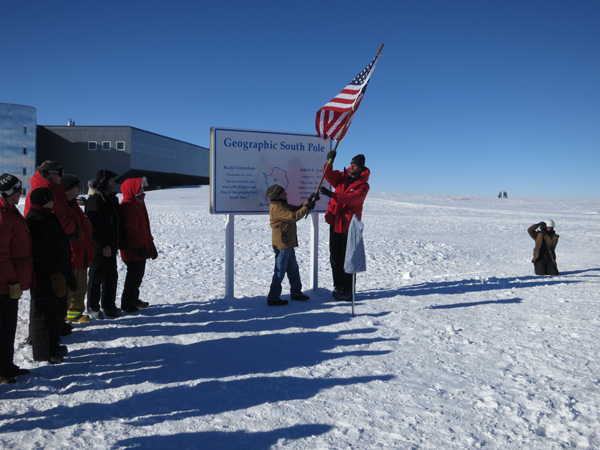
Unveiling of the new South Pole Marker. In a New Year's tradition at NSF's Amundsen-Scott South Pole Station, a handmade marker, designed and created on-site, is revealed to designate the geographic South Pole. Because the ice sheet moves each year, it is necessary to mark the Pole annually. Read more about the annual event. Photo credit: Murat Aydin
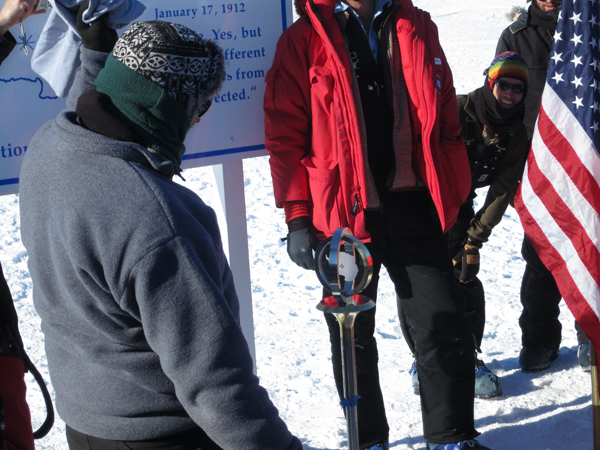
Unveiling of the new South Pole Marker. In a New Year's tradition at NSF's Amundsen-Scott South Pole Station, a handmade marker, designed and created on-site, is revealed to designate the geographic South Pole. Because the ice sheet moves each year, it is necessary to mark the Pole annually. Read more about the annual event. Photo credit: Murat Aydin
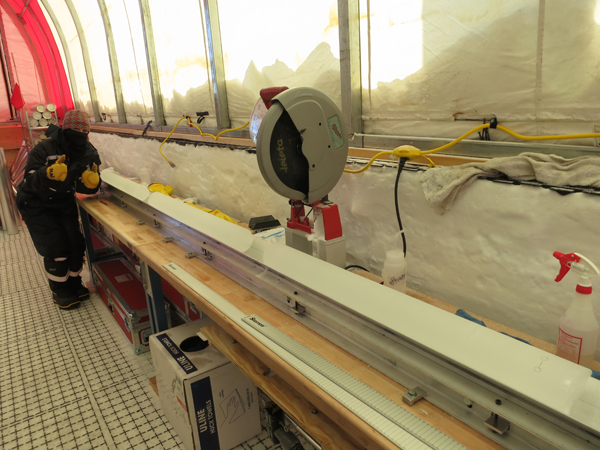
Mindy Nicewonger at the core processing station inside the drill tent. The drill recovers ice cores approximately 2-meters in length. The 2-meter long sections of core are then cut into 1-meter long sections so that they fit into the standard-sized insulated shipping container (ISC) boxes used by the US ice-coring community to transport ice cores. A dry-cut circular saw is used to make the cuts. Photo credit: Murat Aydin.

Inside the core storage trench. The trench serves as a storage area for all of the drilled ice until it is ready to be flown from South Pole Station to McMurdo Station. In addition, all of the ice from the 'brittle ice zone' is stored in the trench over winter to provide more time to relax internal stresses before the ice is shipped back to the U.S. Photo credit: Leah Street
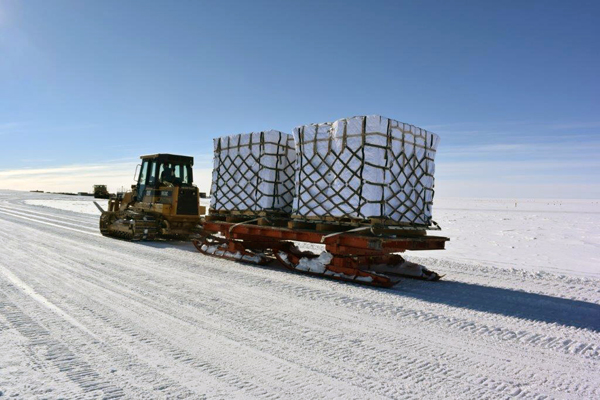
300 meters of ice core on its way from the drill site to South Pole Station for a cold-deck LC-130 flight to McMurdo Station. South Pole Station is 850 miles (1,360 km) south of McMurdo Station. Once in McMurdo, the ice cores are loaded into 40-foot long refrigerated containers with fully redundant cooling and power generation systems. The refrigerated containers are then loaded on the U.S. Antarctic Program's cargo vessel and transported to Port Hueneme (PTH), California. Once the cargo vessel reaches PTH, the refrigerated containers are loaded onto flatbed semi-trailer trucks and driven 1600km to the National Ice Core Laboratory (NICL) in Denver, Colorado. Once at the NICL, the ice cores are unloaded from the refrigerated containers and moved into the NICL’s -36 degree C archive freezer. Photo credit: Leah Street.
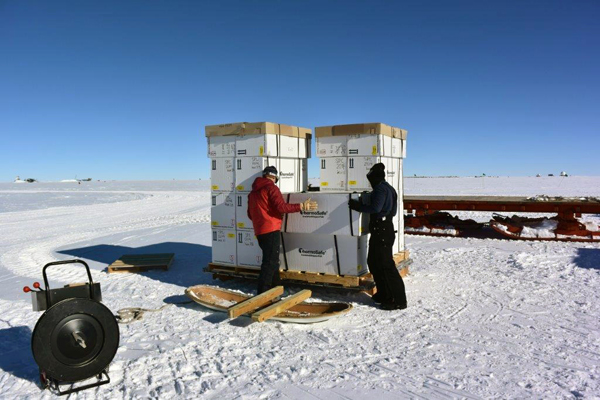
Building the air force pallets (AFPs) of ice cores. The white boxes are standard-sized insulated shipping container (ISC) boxes used by the US ice-coring community to transport ice cores. Each ISC box contains five 1-meter long sections of ice core. Each AFP contains up to 32 ISC boxes, which equates to 160 meters of ice. Photo credit: Leah Street.
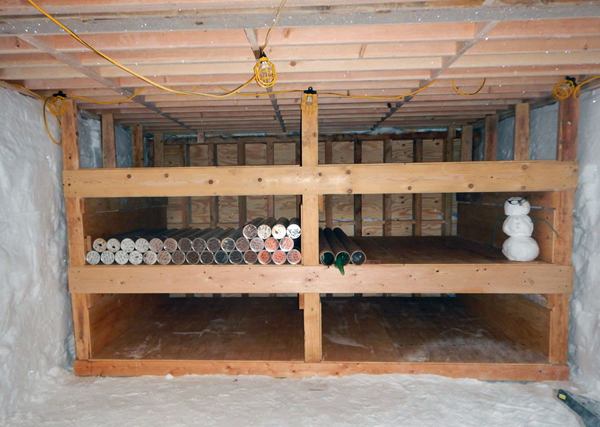
Inside the core storage trench. The trench serves as a storage area for all of the drilled ice until it is ready to be flown from South Pole Station to McMurdo Station. In addition, all of the ice from the 'brittle ice zone' is stored in the trench over winter to provide more time to relax internal stresses before the ice is shipped back to the U.S. Shown here are the shelves for storing the brittle ice. Photo credit: T.J. Fudge.
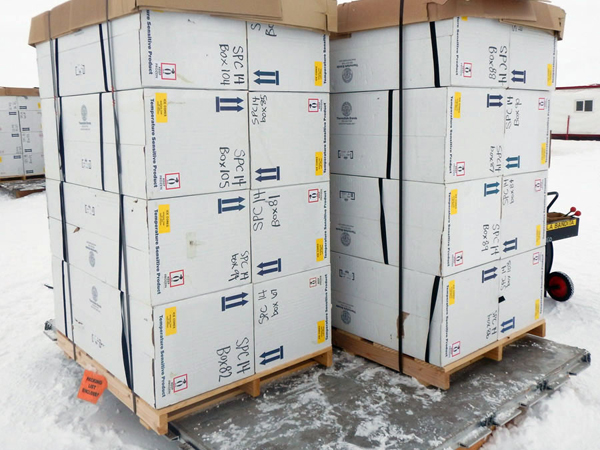
Building the air force pallets (AFPs) of ice cores. The white boxes are standard-sized insulated shipping container (ISC) boxes used by the US ice-coring community to transport ice cores. Each ISC box contains five 1-meter long sections of ice core. Each AFP contains up to 32 ISC boxes, which equates to 160 meters of ice. Photo credit: T.J. Fudge.
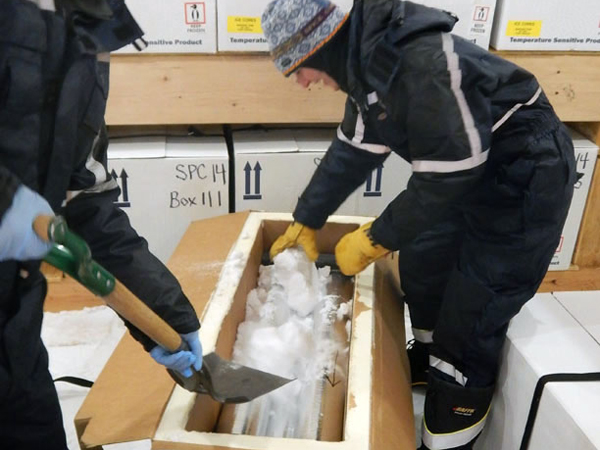
Packing the insulated shipping container (ISC) box with ice cores. Each ISC box can hold five 1 meter long sections of the ice core. The 1 meter long sections of ice core are put into 0.152 mm (6 mil) thick polyethylene ’layflat’ tubing and then into aluminum-coated cardboard core tubes. The core tubes are then packed into ISC boxes, with the voids around each core tube filled with snow. Photo credit: T.J. Fudge.
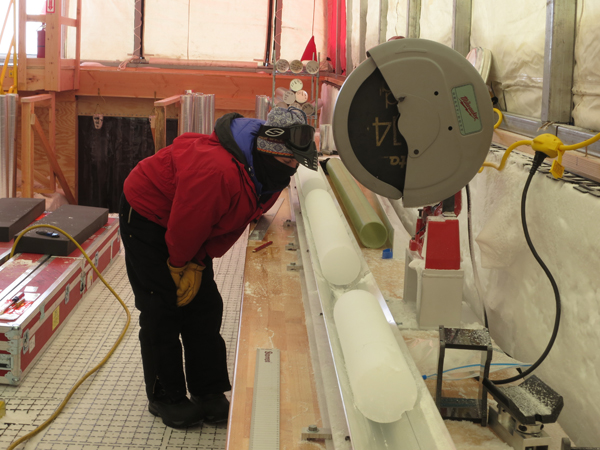
View of the core processing station inside the drill tent. The drill recovers ice cores approximately 2-meters in length. The 2-meter long sections of core are then cut into 1-meter long sections, as shown in the photo, so that they fit into the standard-sized insulated shipping container (ISC) boxes used by the US ice-coring community to transport ice cores. A dry-cut circular saw is used to make the cuts. Photo credit: Murat Aydin.
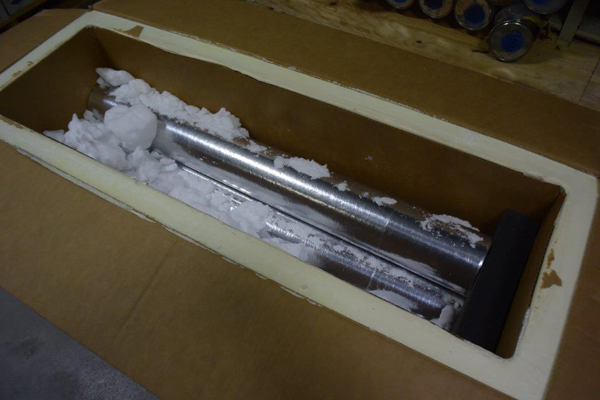
Retrograded ice cores from the 2014-15 field season safely inside the NSF Ice Core Facility (NSF-ICF) in Denver, CO. Inside each silver tube is a 1-meter long section of the ice core. Each insulated box holds five 1-meter long sections of ice core. The ice is stored inside NICL's -36 degree C main archive freezer. Photo credit: Leah Street.
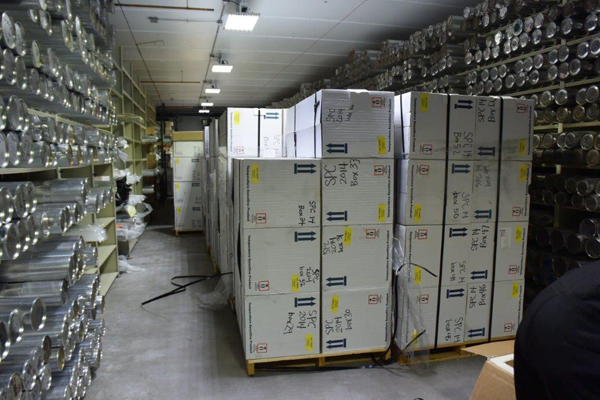
The retrograded ice cores from the 2014-15 field season safely inside the NSF Ice Core Facility (NSF-ICF) freezer in Denver, Colorado. The ice is stored inside NSF-ICF's -36 degree C main archive freezer. Each white box contains five 1-meter long sections of the ice core. A total of 580 meters from the SPICE core, along with two 10-meter long firn cores, were shipped to the NSF-ICF. The ice arrived safely in Port Hueneme (PTH), CA, on February 28, via the U.S. Antarctic Program’s cargo vessel. During the evening of March 3, the ice left PTH and arrived to the NSF-ICF at about 8:30pm on March 4. The ice was in the SAFECORE refrigerated container for the entire journey. Photo credit: Leah Street.
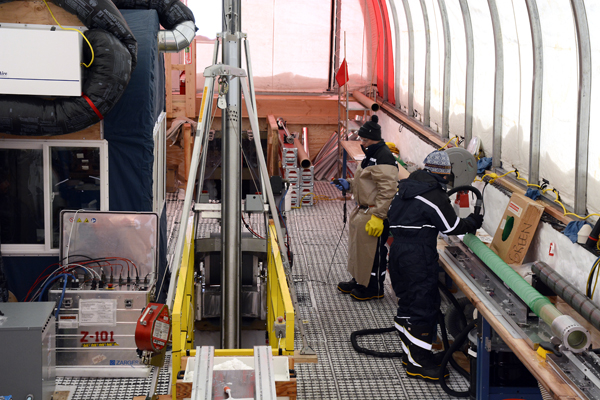
The South Pole Ice Core (SPICEcore) drilling operation. In the center of the photo is the drill. At right a science team member is cleaning and preparing an extracted ice core for placement in a tube, for later transportation to the National Ice Core Lab in Denver, Colorado. Photograph By: Peter Rejcek, National Science Foundation.
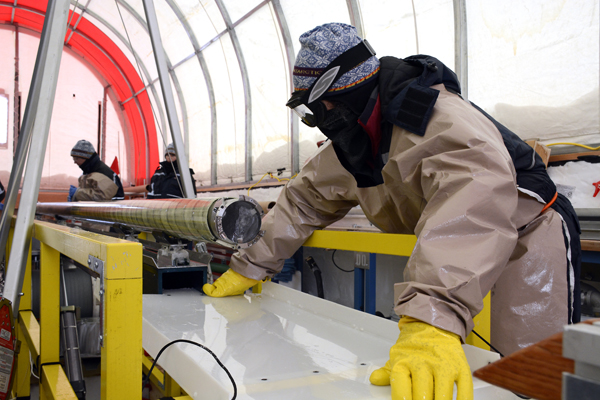
A science team member prepares to extract an ice core from the drill. The South Pole Ice Core (SPICEcore) project plans to drill to a depth of 1,500 meters, a depth that is estimated to cover about 40,000 years of climate history. This is part of an initiative called International Partnerships in Ice Core Sciences, which seeks to create a network of ice cores over similar timescales spread across both Antarctica and Greenland. The target of 40,000 years represents the transition from the last ice age, known as a glacial, to the present warm period called an interglacial. [Note: the project actually drilled to 1751 meters depth, covering the last 54,000 years of Earth's history.] Photograph By: Peter Rejcek, National Science Foundation.
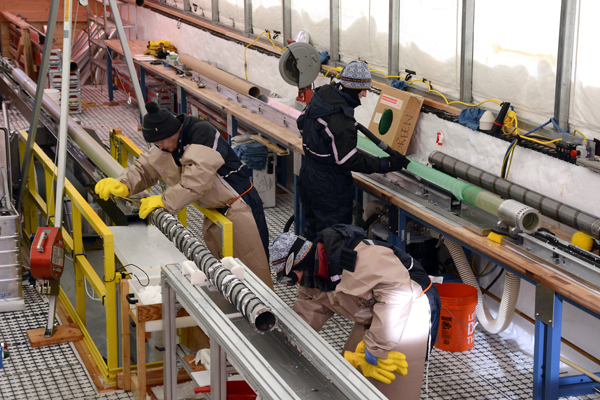
Science team members work in the South Pole Ice Core (SPICEcore) drilling tent, cleaning the drill and measuring ice cores. The Ice Drilling Design and Operations (IDDO) group at the University of Wisconsin-Madison designed and built the drilling system, called the Intermediate Depth Drill. Based on a Danish drill called the Hans-Taunsen drill, the Intermediate Depth Drill was purpose-built for coring 1,500 meters of ice. Photograph By: Peter Rejcek, National Science Foundation

Inside the South Pole Ice Core (SPICEcore) drill tent. The Ice Drilling Design and Operations (IDDO) group at the University of Wisconsin-Madison designed and built the drilling system, called the Intermediate Depth Drill. Based on a Danish drill called the Hans-Taunsen drill, the Intermediate Depth Drill was purpose-built for coring 1,500 meters of ice. Photograph By: Peter Rejcek, National Science Foundation.
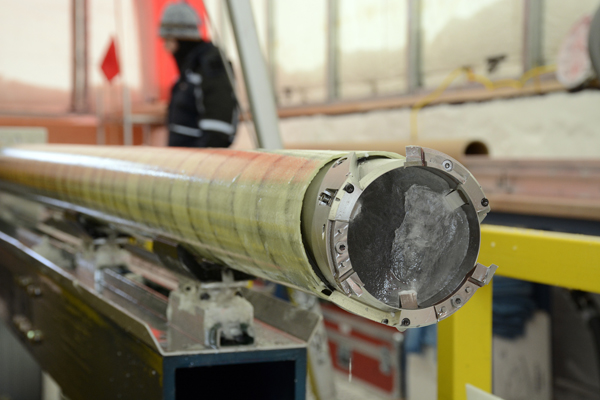
A close-up of an ice core still in the drill barrel. SPICEcore (South Pole Ice Core) will drill to a depth of 1,500 meters, collecting atmospheric gases from 40,000 years ago, the time of transition from the last ice age to the current warm climate. The project is part of a global effort to collect ice from this same time period around the world. [Note: the project actually drilled to 1751 meters depth, covering the last 54,000 years of Earth's history.] Photograph By: Peter Rejcek, National Science Foundation.
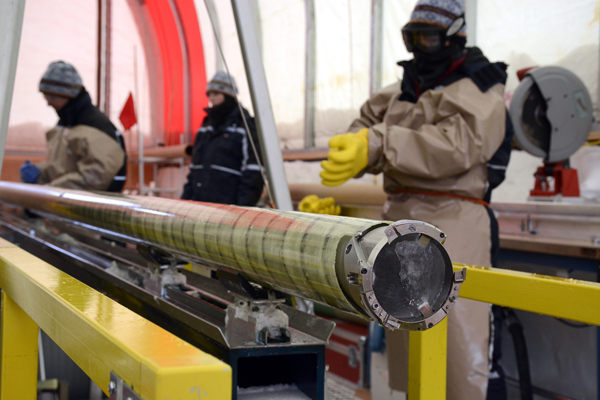
The Ice Drilling Design and Operations (IDDO) group at the University of Wisconsin-Madison designed and built the South Pole Ice Core (SPICEcore) drilling system, called the Intermediate Depth Drill. Based on a Danish drill called the Hans-Taunsen drill, the Intermediate Depth Drill was purpose-built for coring 1,500 meters of ice. The ice cores collected at this depth contain atmospheric gases from the past 40,000 years, the time of transition from the last ice age to the present warm climate. [Note: the project actually drilled to 1751 meters depth, covering the last 54,000 years of Earth's history.] Photograph By: Peter Rejcek, National Science Foundation.
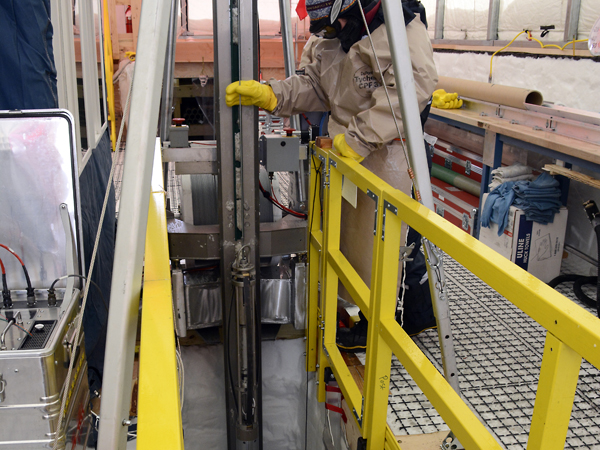
The South Pole Ice Core (SPICEcore) drill returns to the surface after retrieving an ice core. The South Pole Ice Core (SPICEcore) project plans to drill to a depth of 1,500 meters, a depth that is estimated to cover about 40,000 years of climate history. This is part of an initiative called International Partnerships in Ice Core Sciences, which seeks to create a network of ice cores over similar timescales spread across both Antarctica and Greenland. The target of 40,000 years represents the transition from the last ice age, known as a glacial, to the present warm period called an interglacial. [Note: the project actually drilled to 1751 meters depth, covering the last 54,000 years of Earth's history.] Photograph By: Peter Rejcek, National Science Foundation

The South Pole Ice Core (SPICEcore) field camp is located about two kilometers from the South Pole Station. The very cold ice at the South Pole is particularly useful for capturing miniscule traces of rare gases in the atmosphere. Carbon dioxide, the most heavily studied gas due to its influence on climate, is measured in parts per million. Some of the gases researchers are interested in studying to understand past climate from the SPICE core are measured in parts per trillion. Photograph By: Peter Rejcek, National Science Foundation.
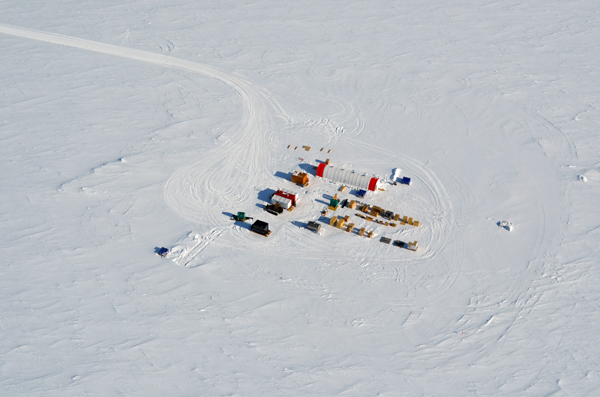
The South Pole Ice Core (SPICEcore) field camp, located a few kilometers from the Amundsen-Scott South Pole Station, was set up during the 2014-15 field season. The 1,500 meters of ice cores extracted from this site will provide an environmental record spanning 40,000 years, covering the transition from the Last Glacial Maximum, when polar ice sheets reached their greatest extent, to the present-day Holocene. The ice at the South Pole is especially cold, which helps preserve rare gases that were in the atmosphere when the snow fell thousands of years ago. Scientists who analyze the ice cores can use these so-called trace gases to reconstruct ancient climate, which also helps researchers understand how climate may change in the future. [Note: the project actually drilled to 1751 meters depth, covering the last 54,000 years of Earth's history.] Photograph By: National Science Foundation.
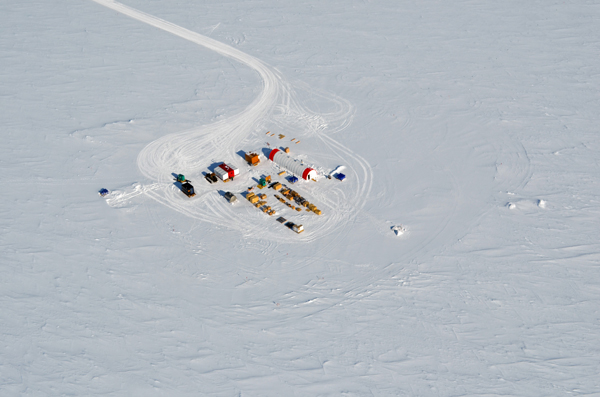
The South Pole Ice Core (SPICEcore) field camp, located a few kilometers from the Amundsen-Scott South Pole Station, was set up during the 2014-15 field season. The 1,500 meters of ice cores extracted from this site will provide an environmental record spanning 40,000 years, covering the transition from the Last Glacial Maximum, when polar ice sheets reached their greatest extent, to the present-day Holocene. The ice at the South Pole is especially cold, which helps preserve rare gases that were in the atmosphere when the snow fell thousands of years ago. Scientists who analyze the ice cores can use these so-called trace gases to reconstruct ancient climate, which also helps researchers understand how climate may change in the future. [Note: the project actually drilled to 1751 meters depth, covering the last 54,000 years of Earth's history.] Photograph By: National Science Foundation.
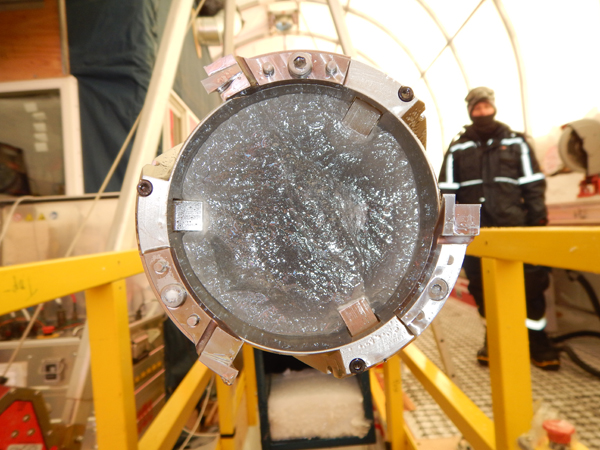
The Ice Drilling Design and Operations (IDDO) group at the University of Wisconsin-Madison designed and built the South Pole Ice Core (SPICEcore) drilling system, called the Intermediate Depth Drill. Based on a Danish drill called the Hans-Taunsen drill, the Intermediate Depth Drill was purpose-built for coring 1,500 meters of ice. The ice cores collected at this depth (from the South Pole) contain atmospheric gases from the past 40,000 years, the time of transition from the last ice age to the present warm climate. [Note: the project actually drilled to 1751 meters depth, covering the last 54,000 years of Earth's history.] Photo credit: T.J. Fudge.
